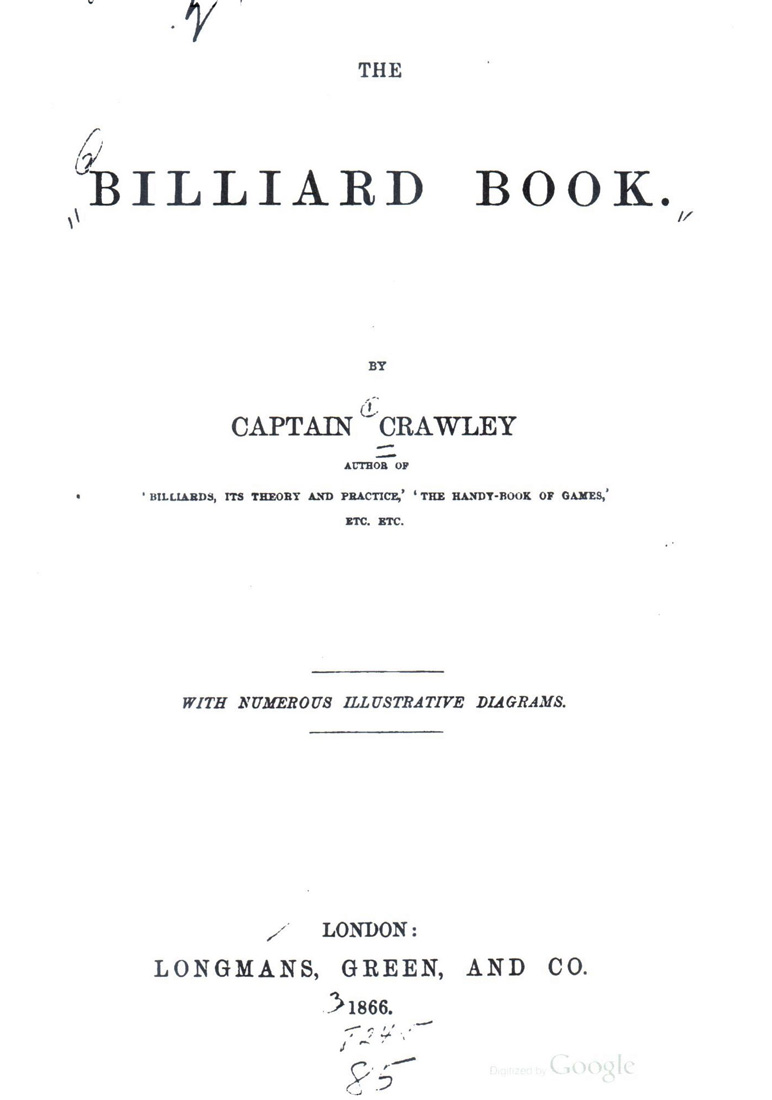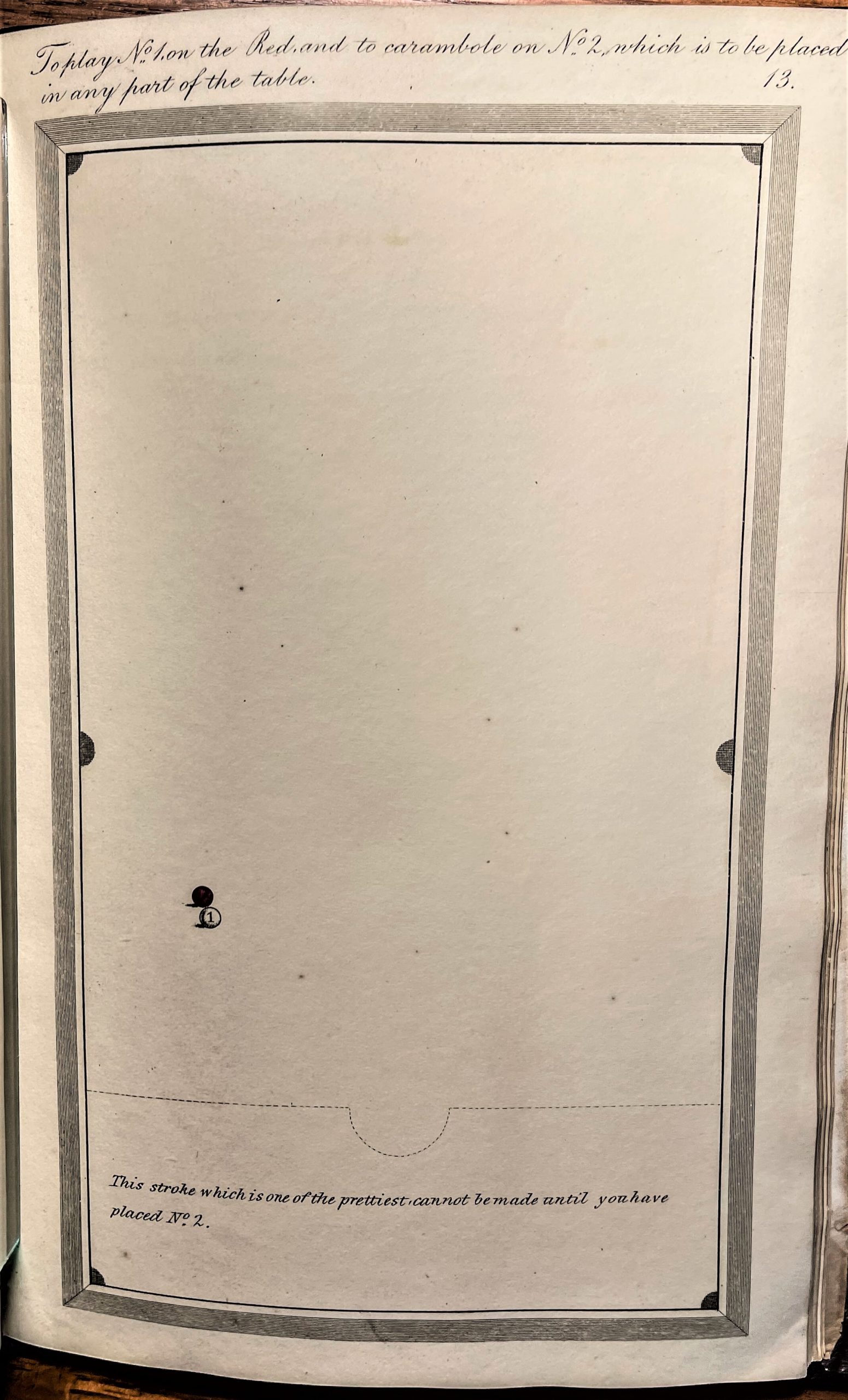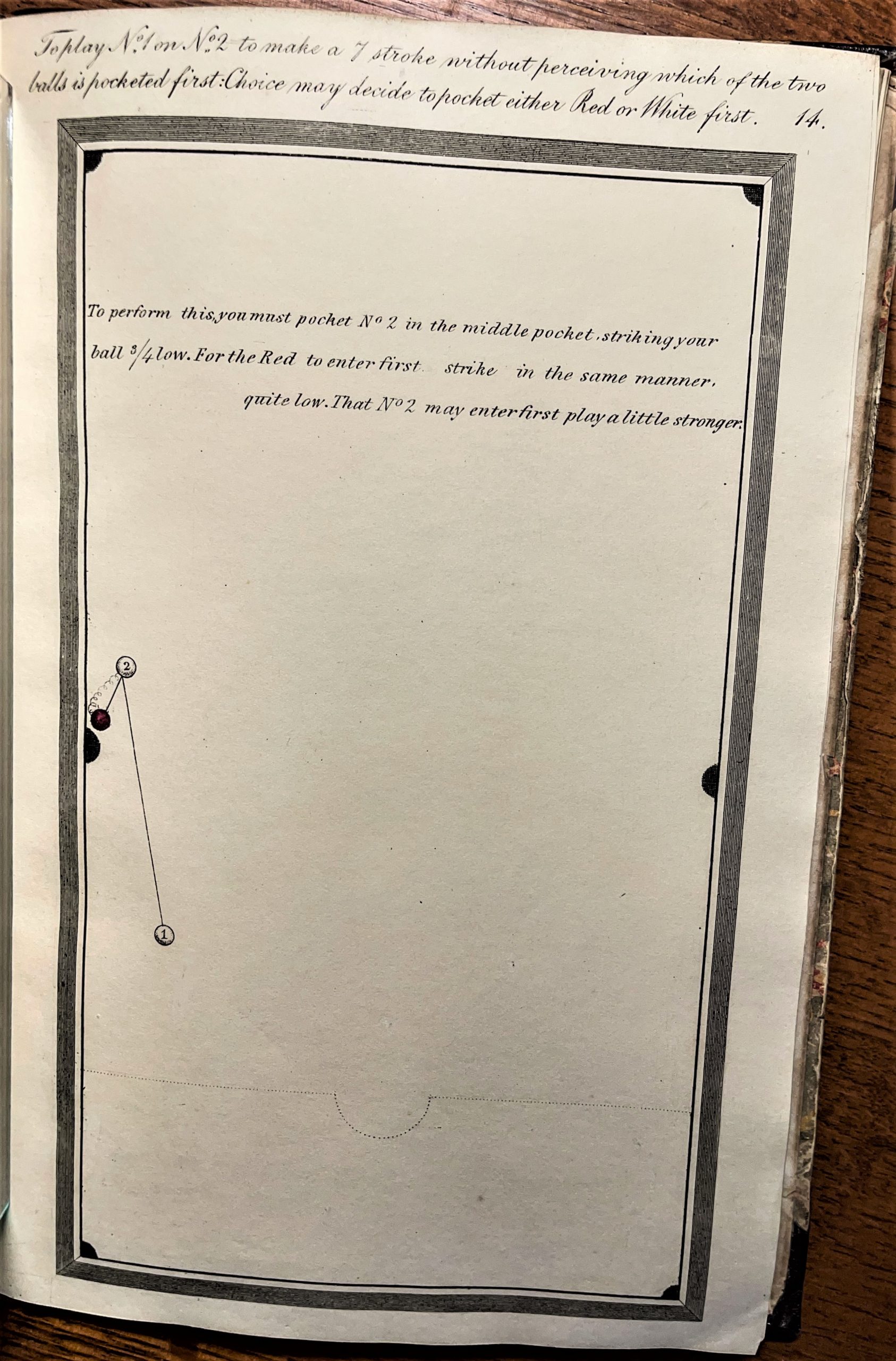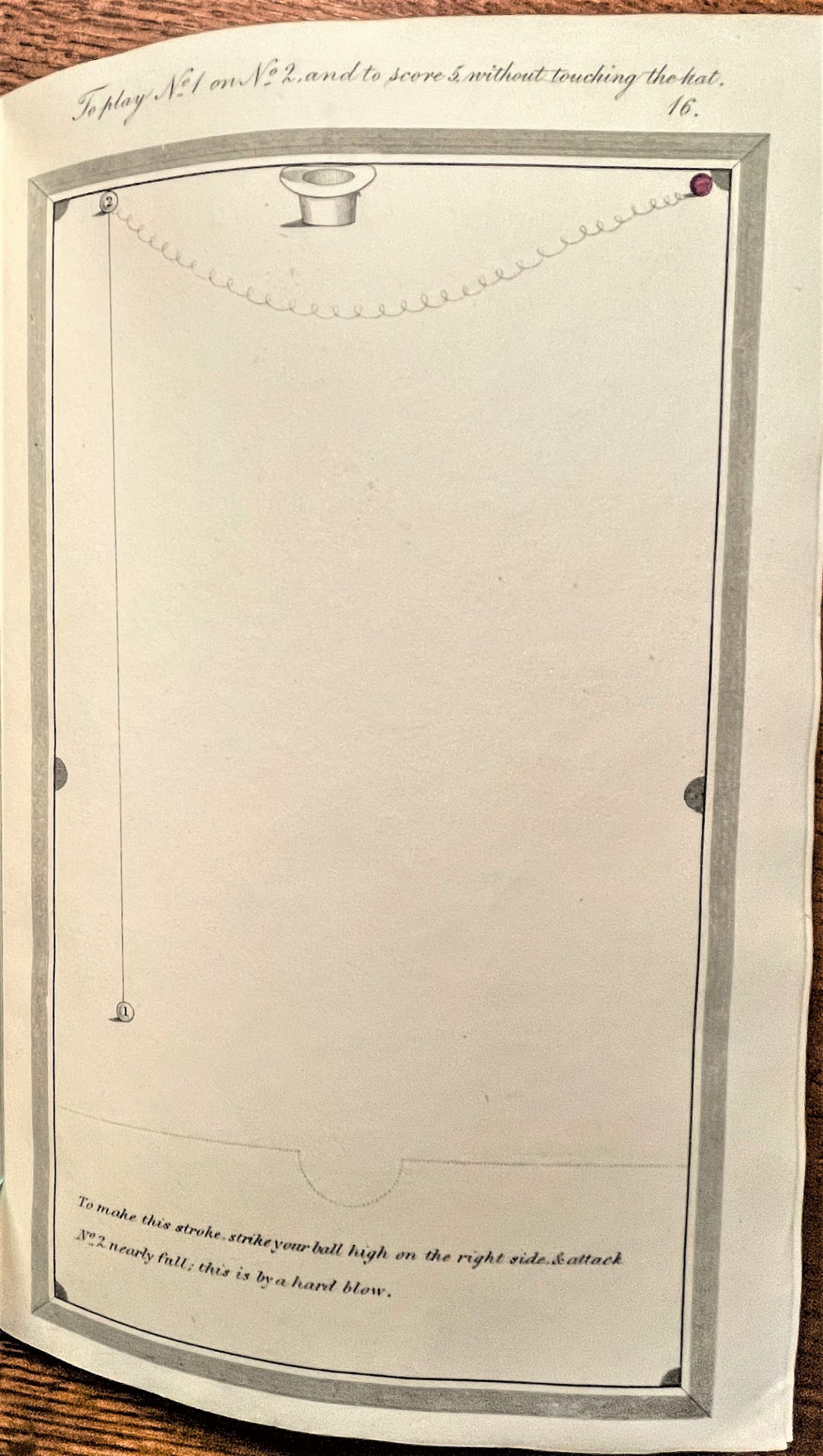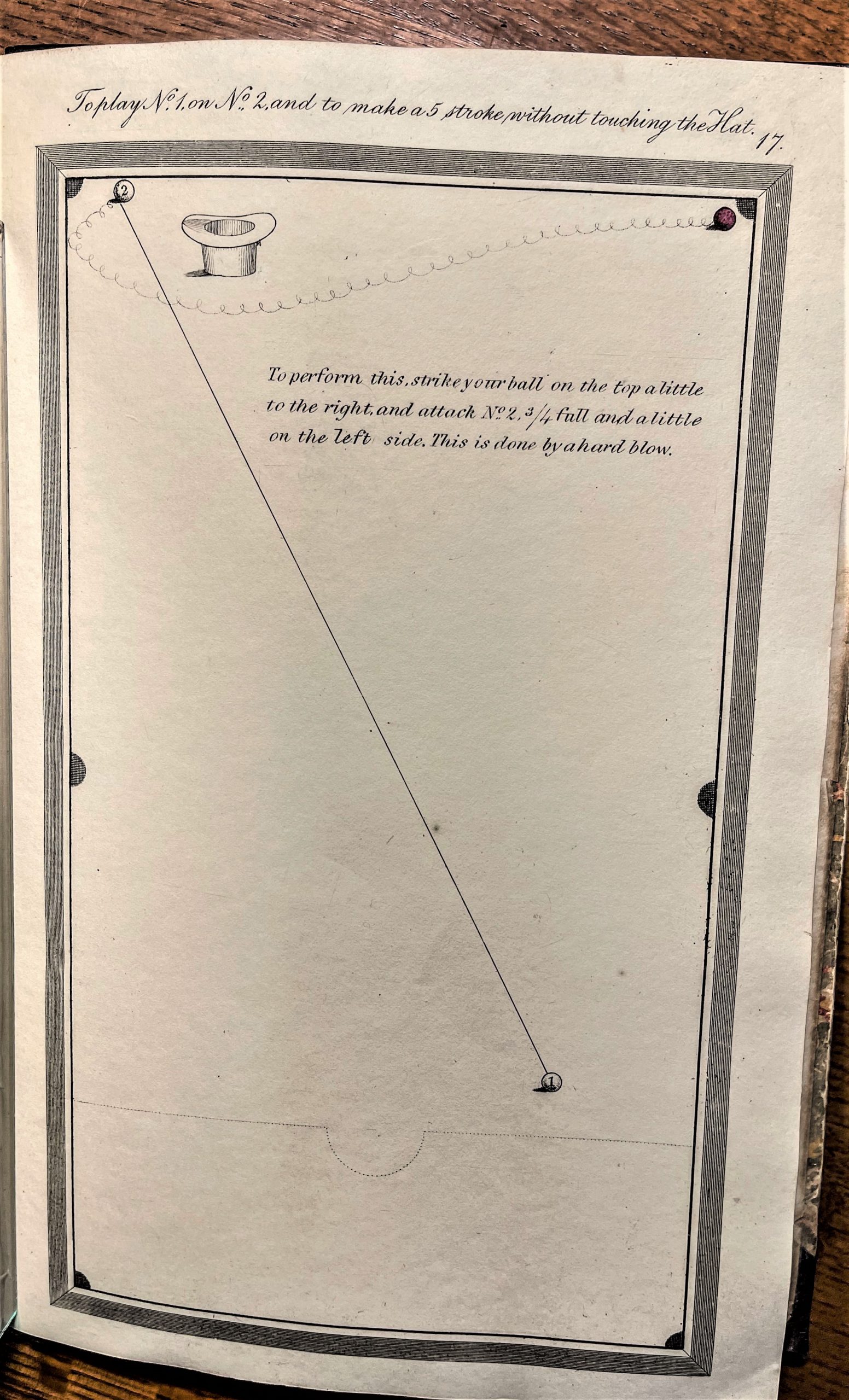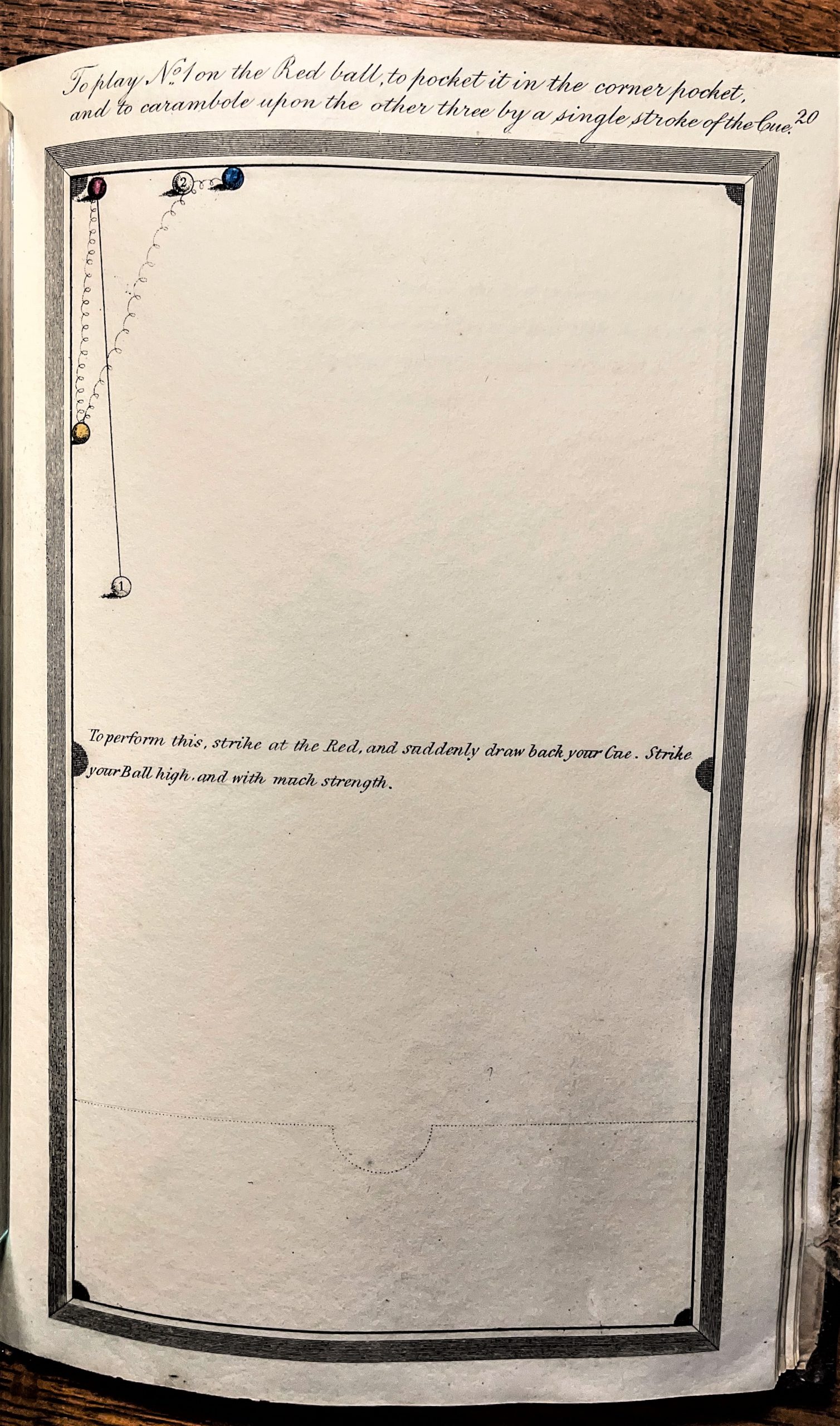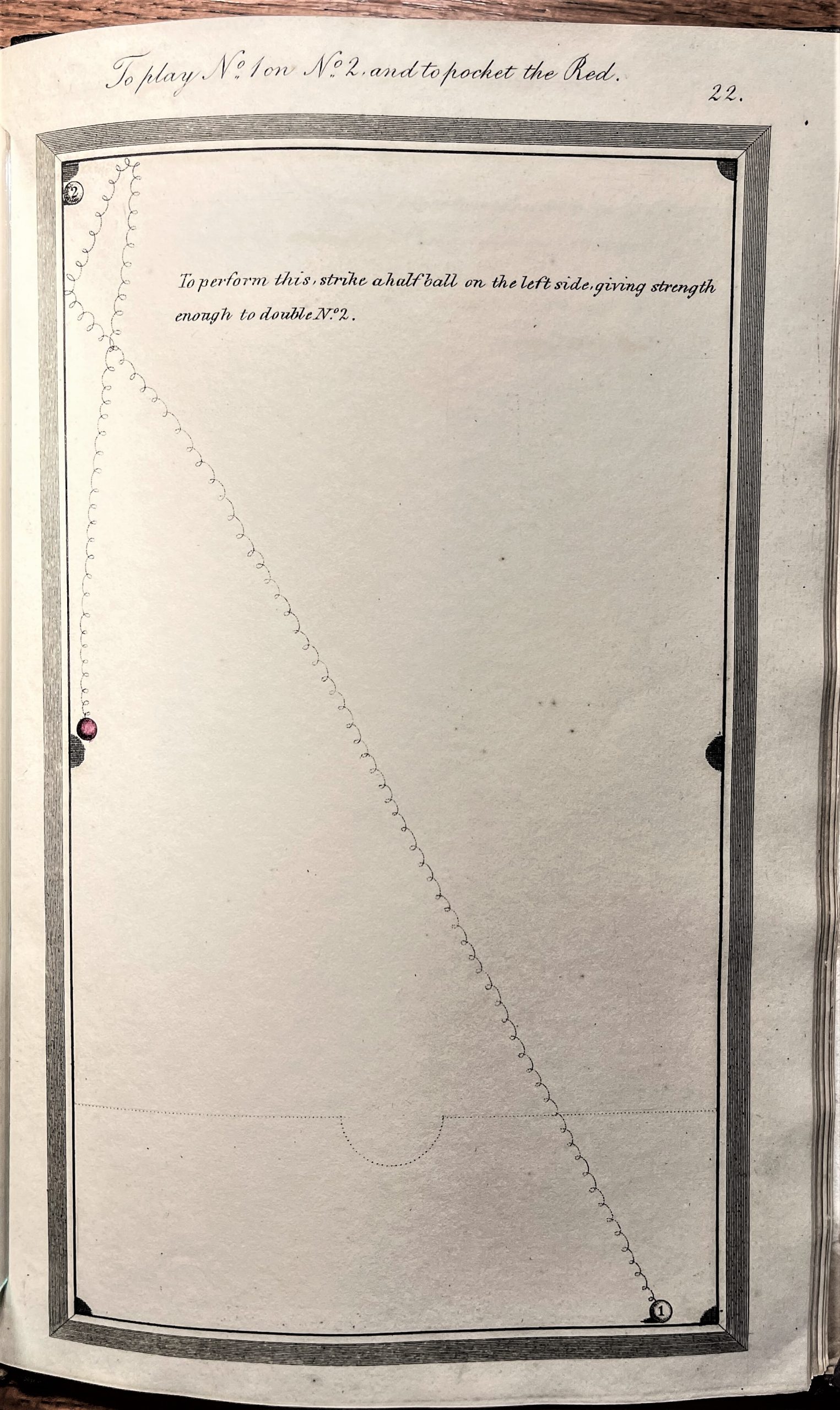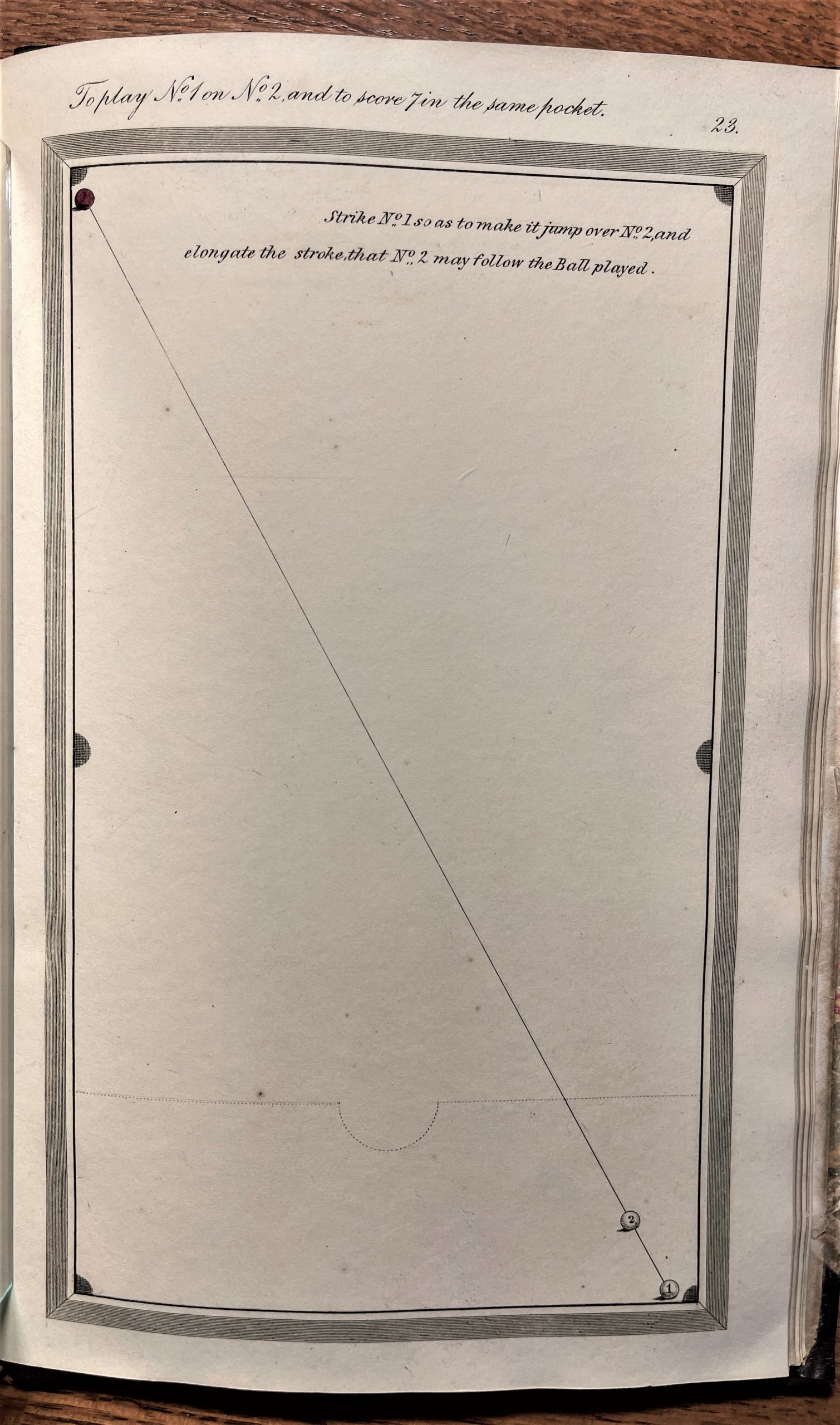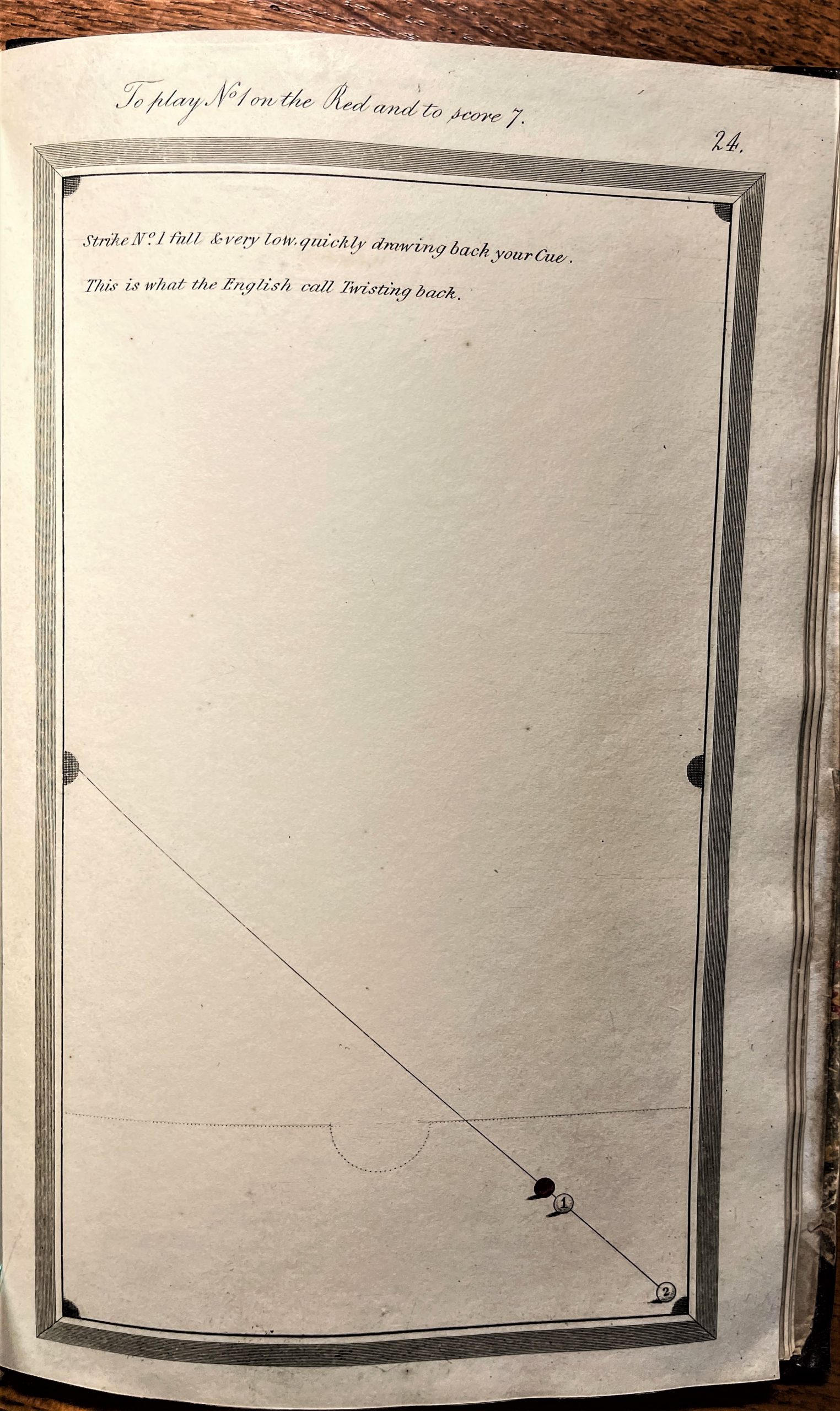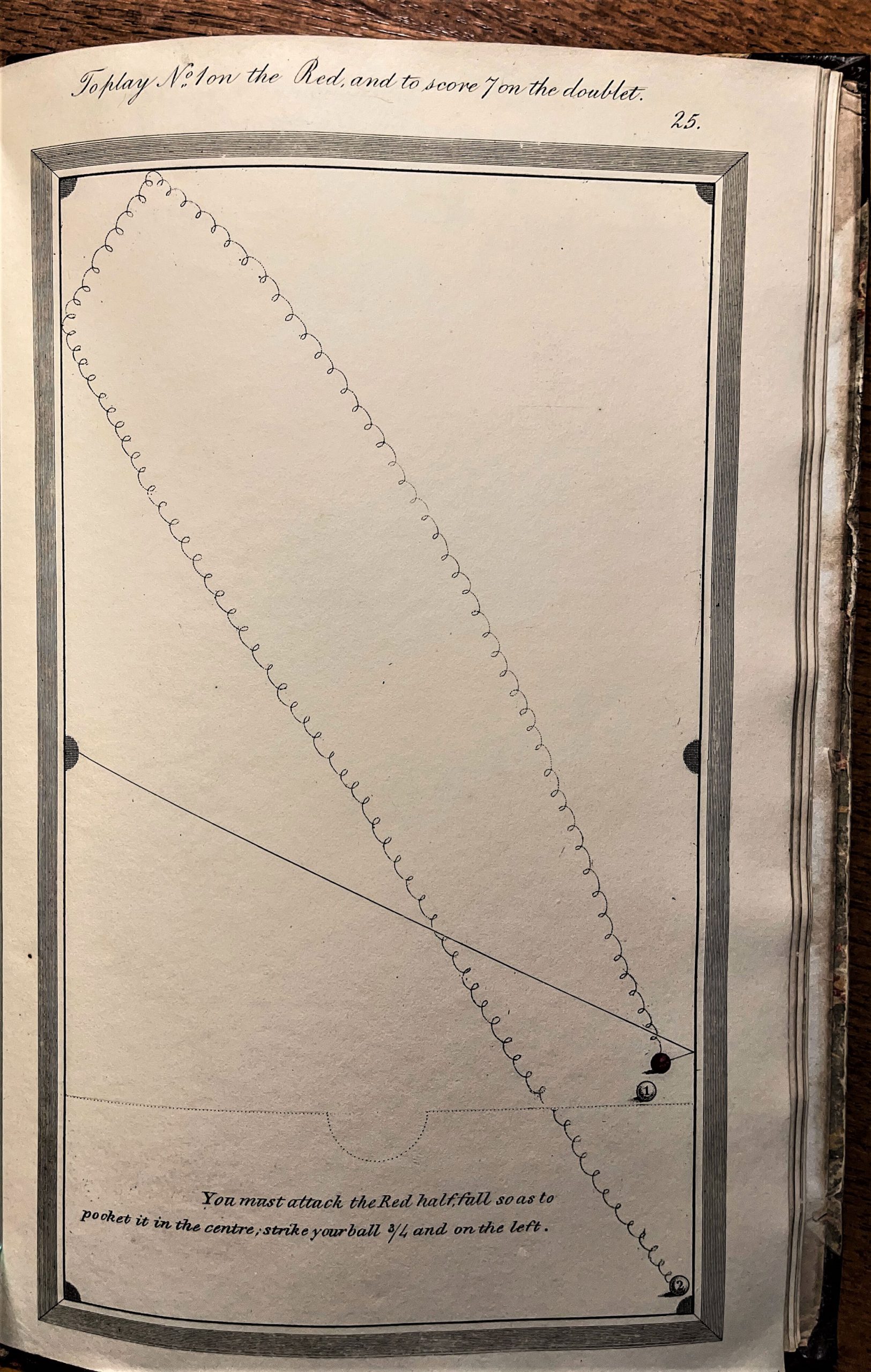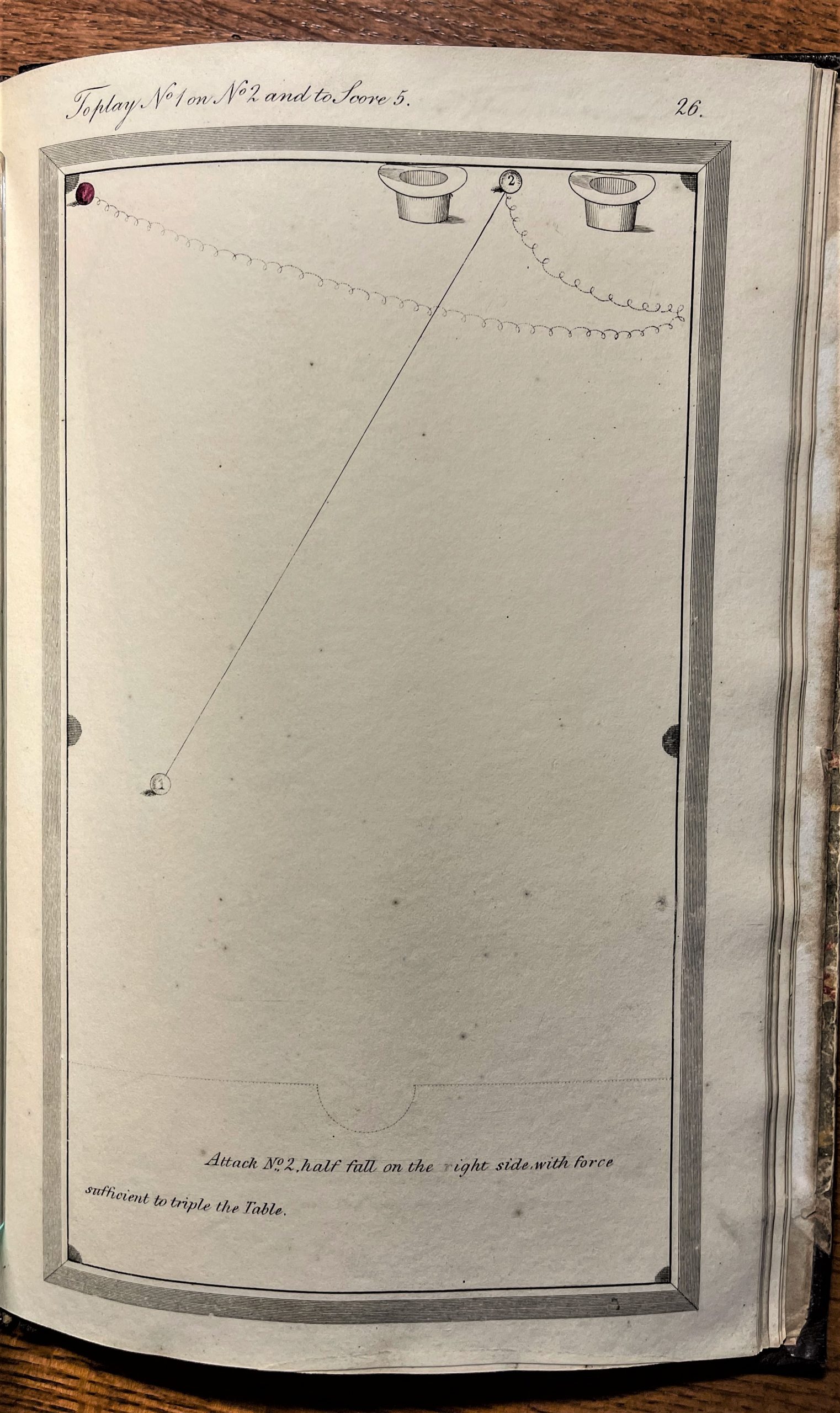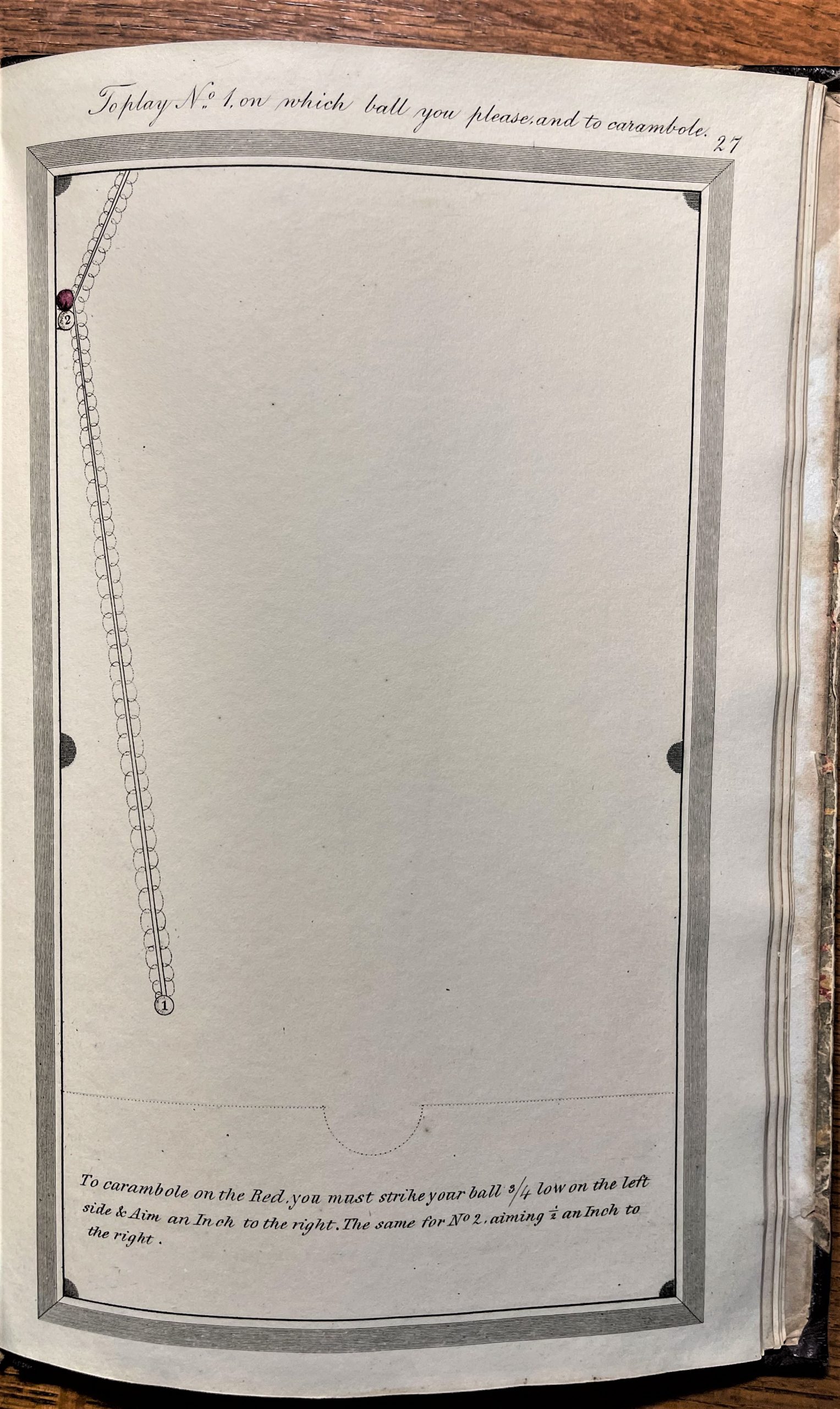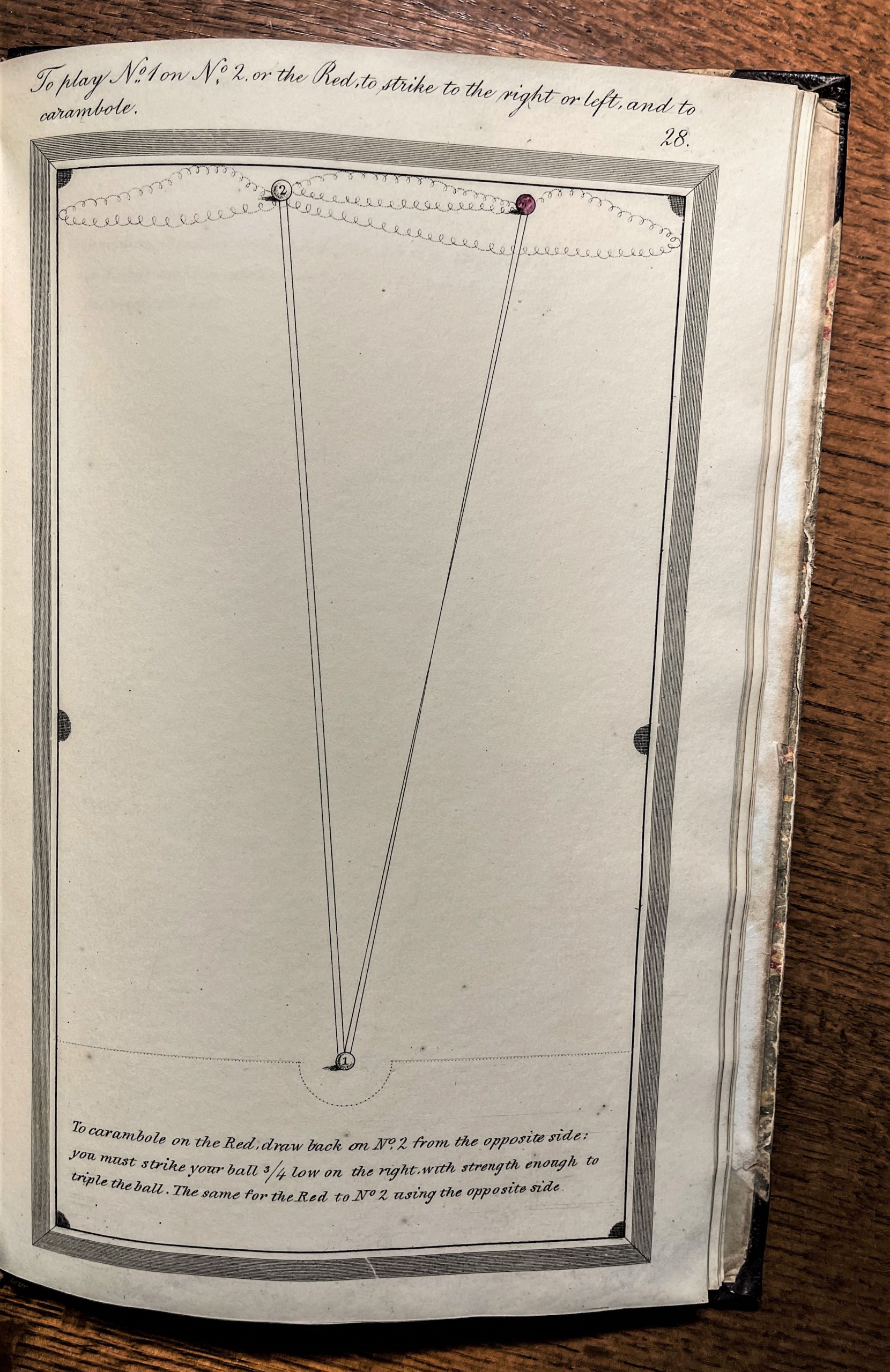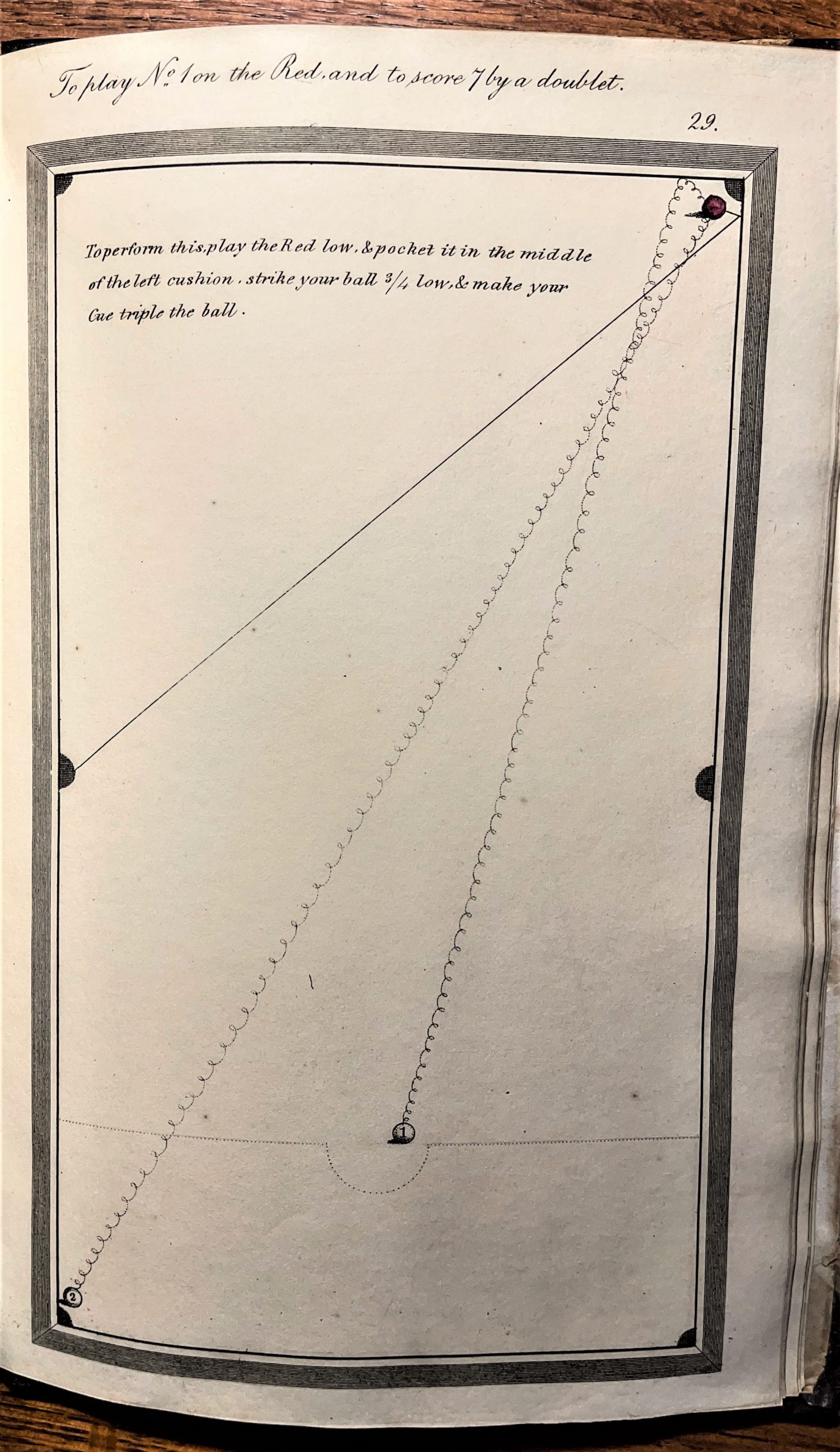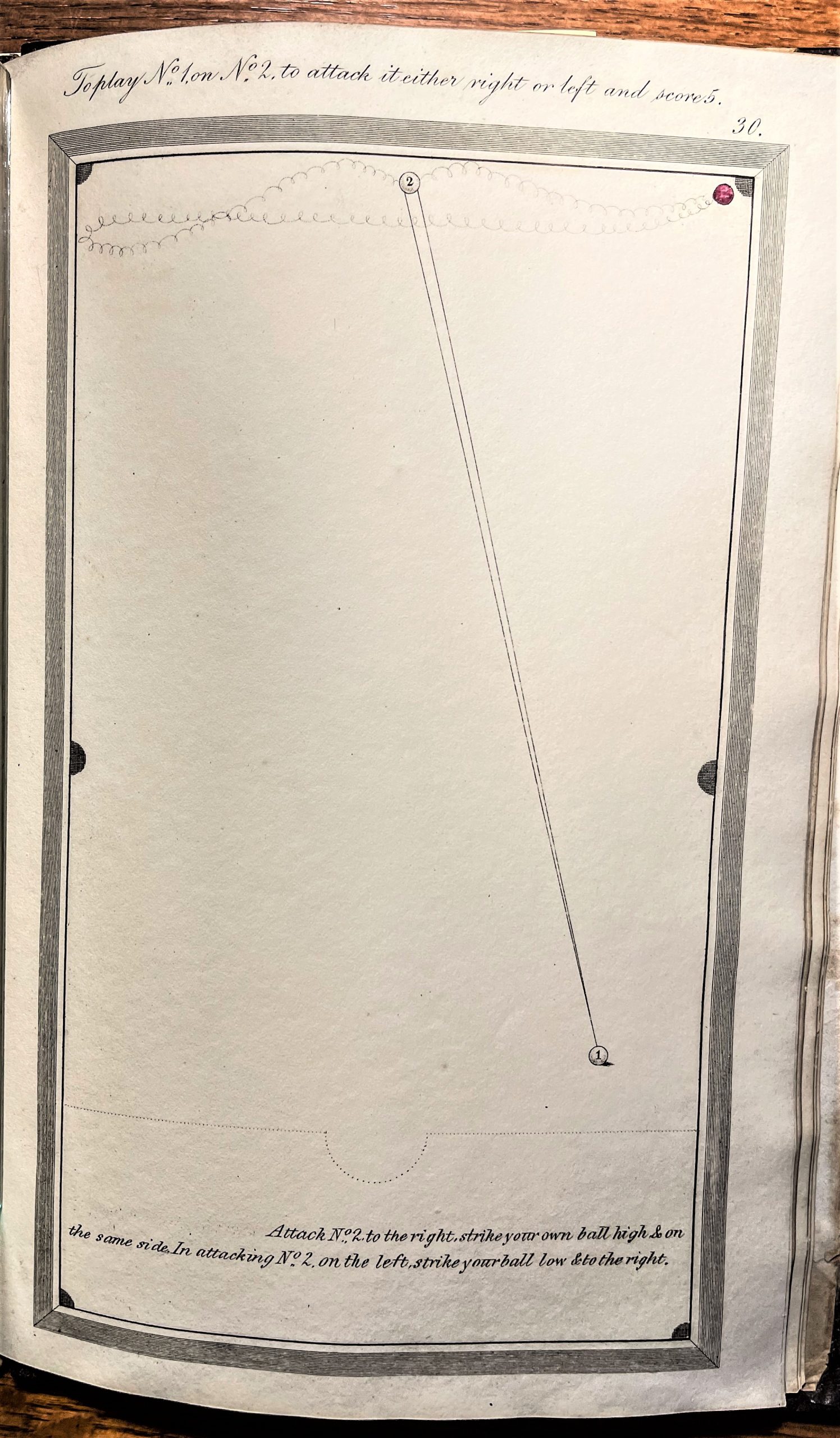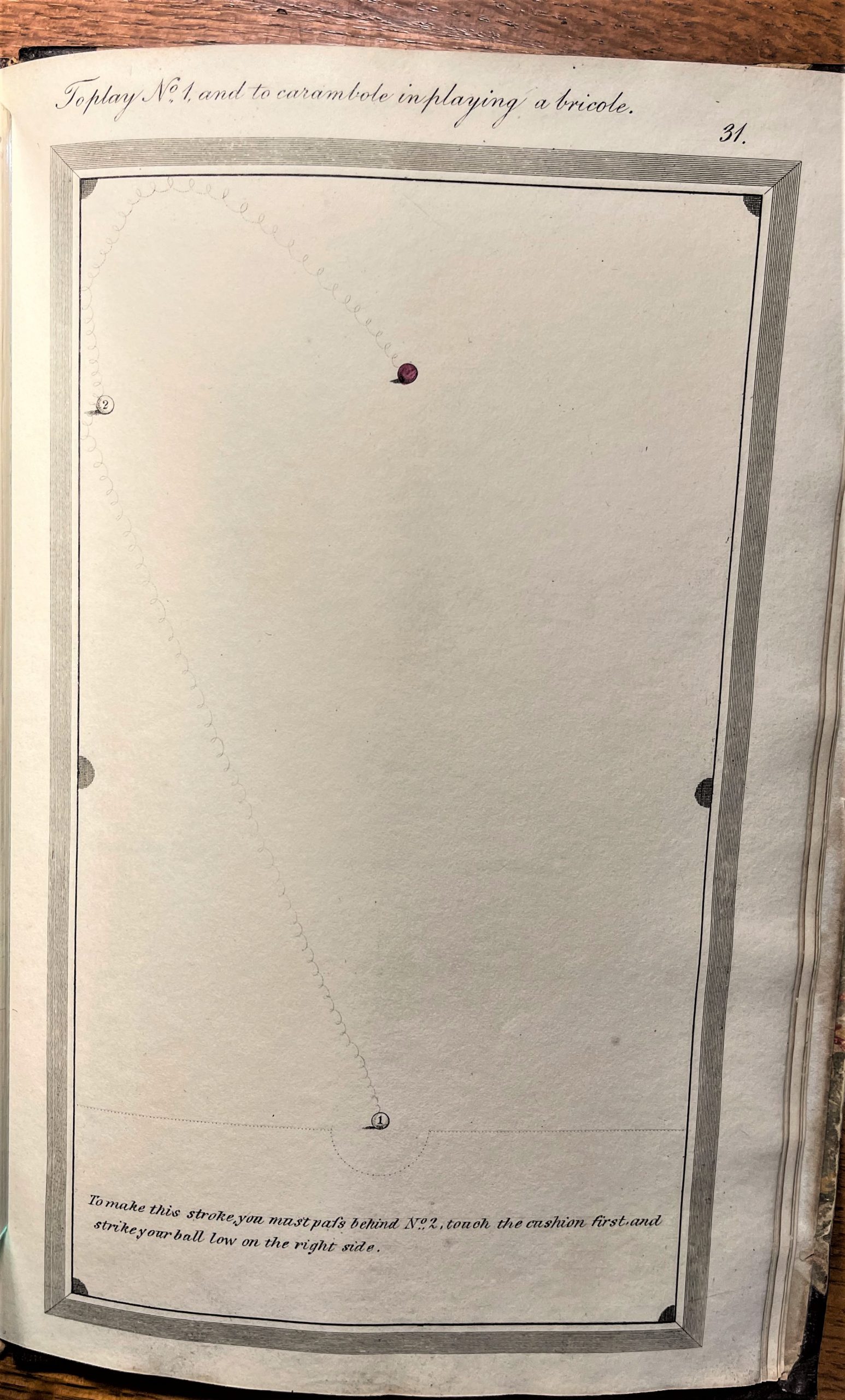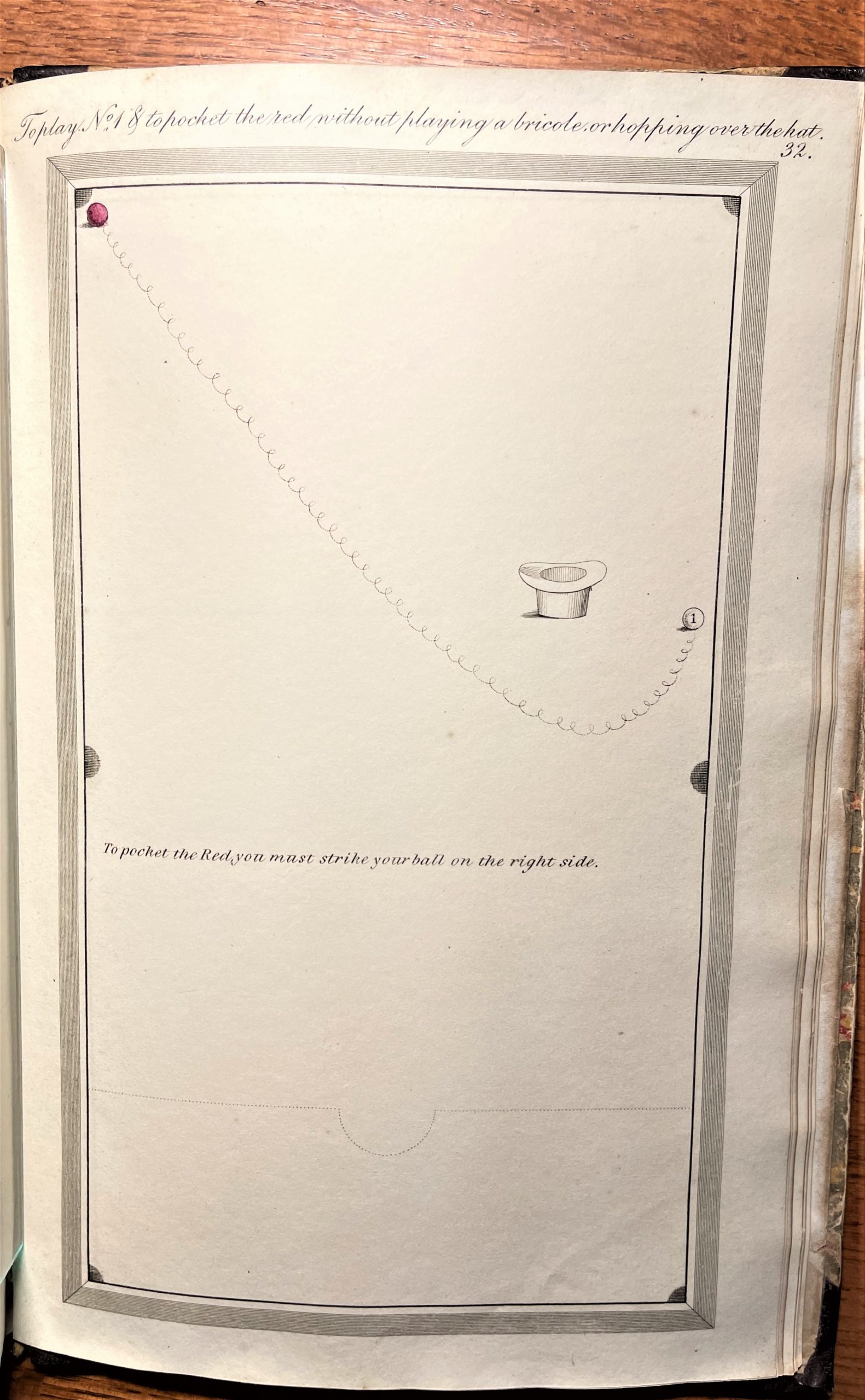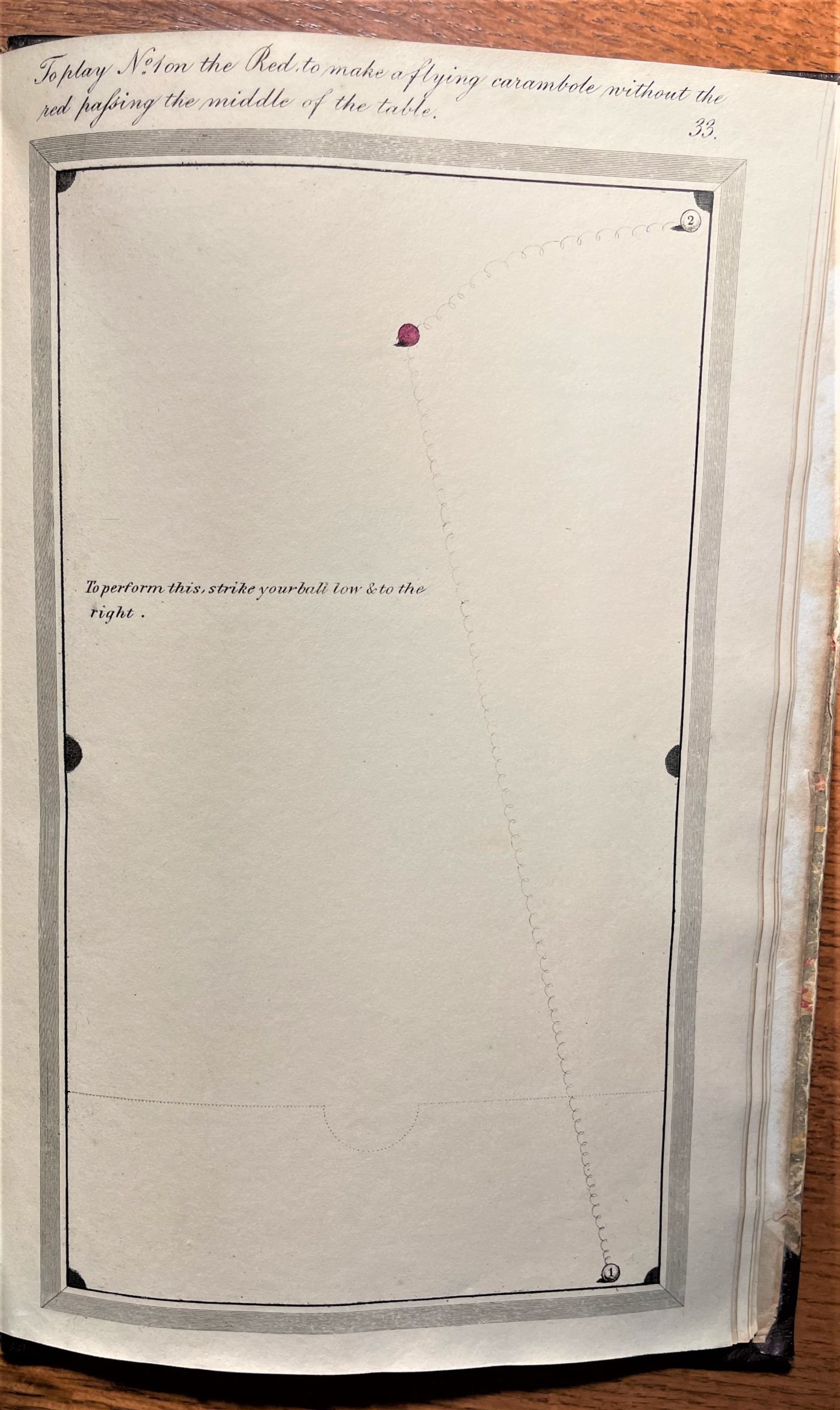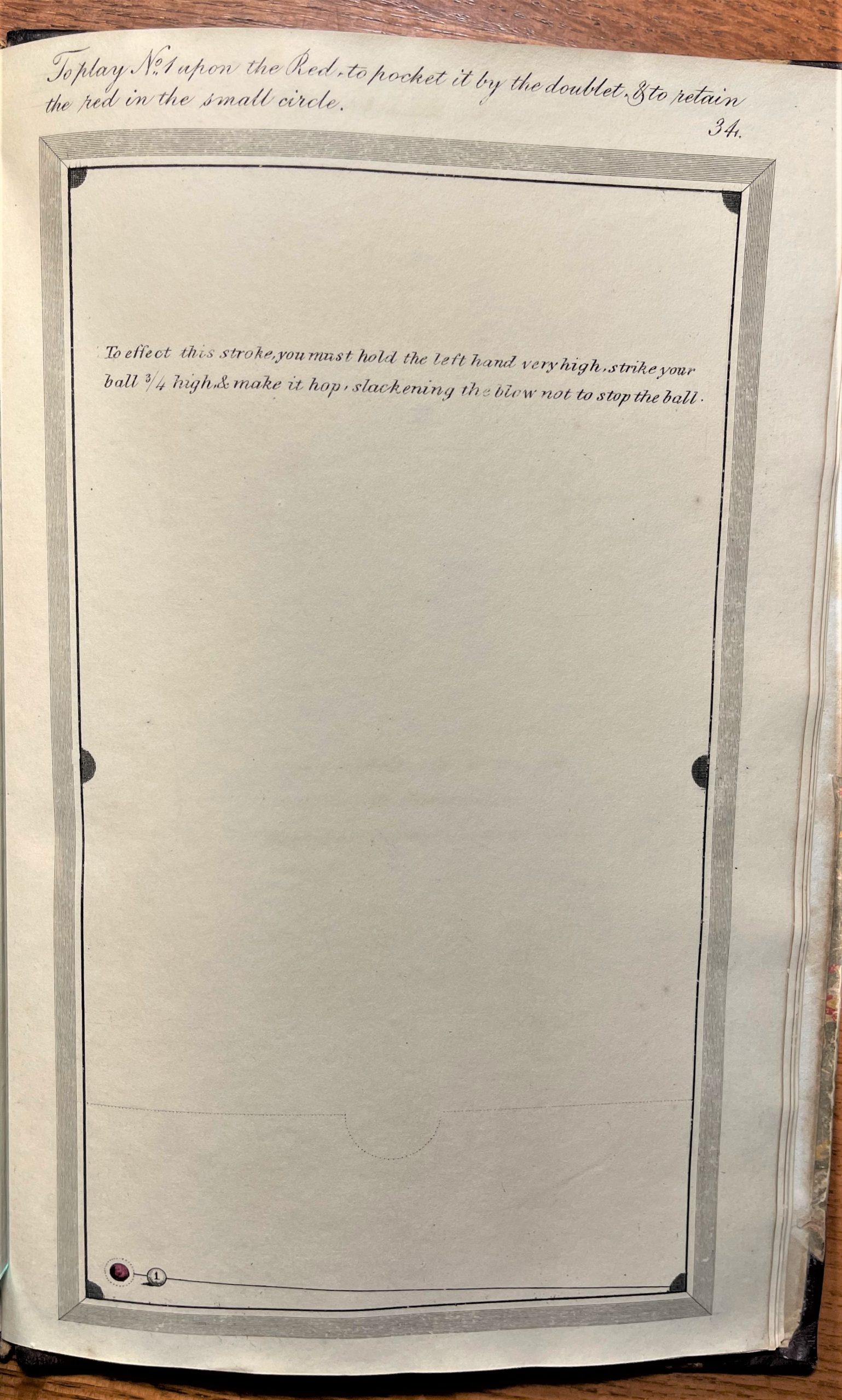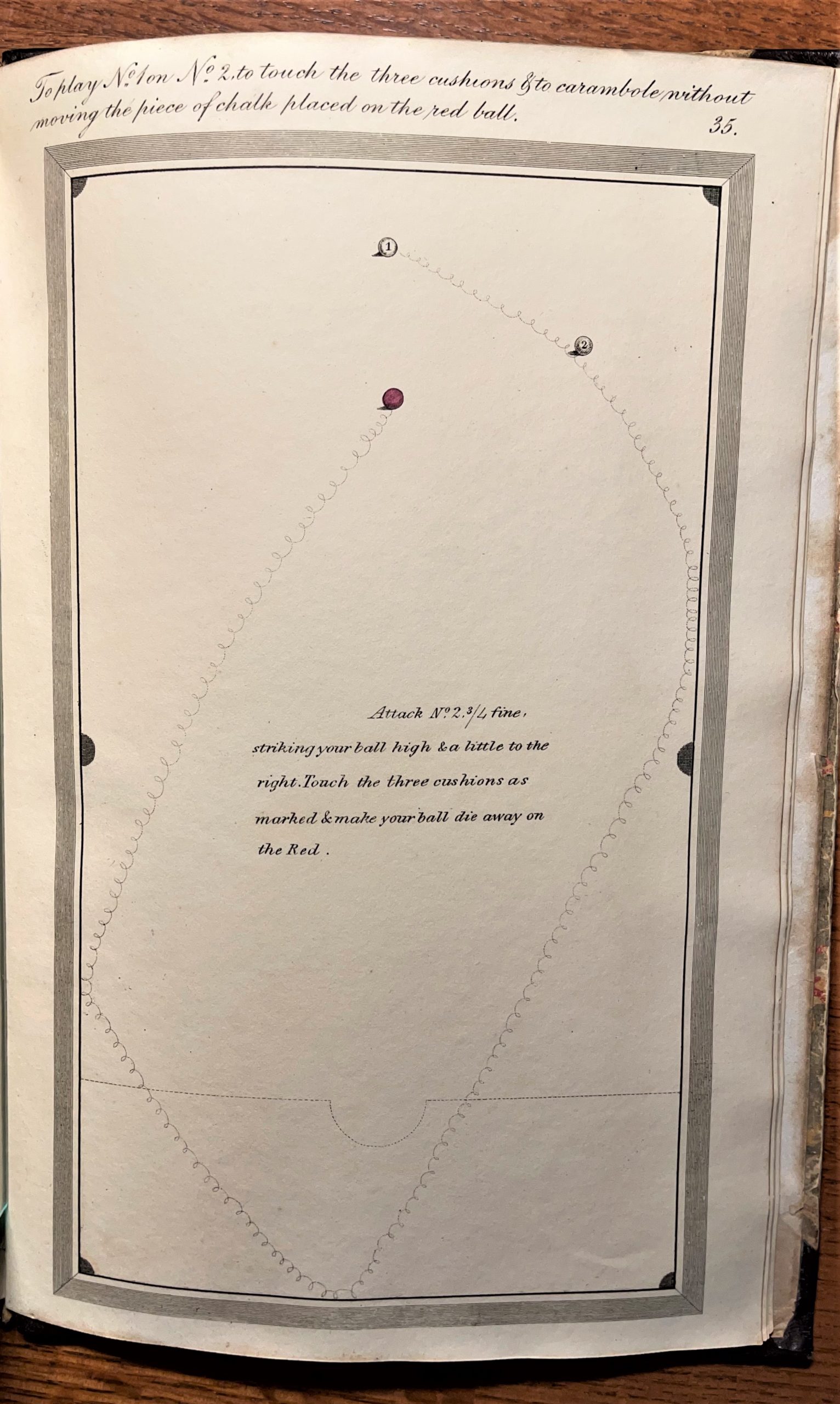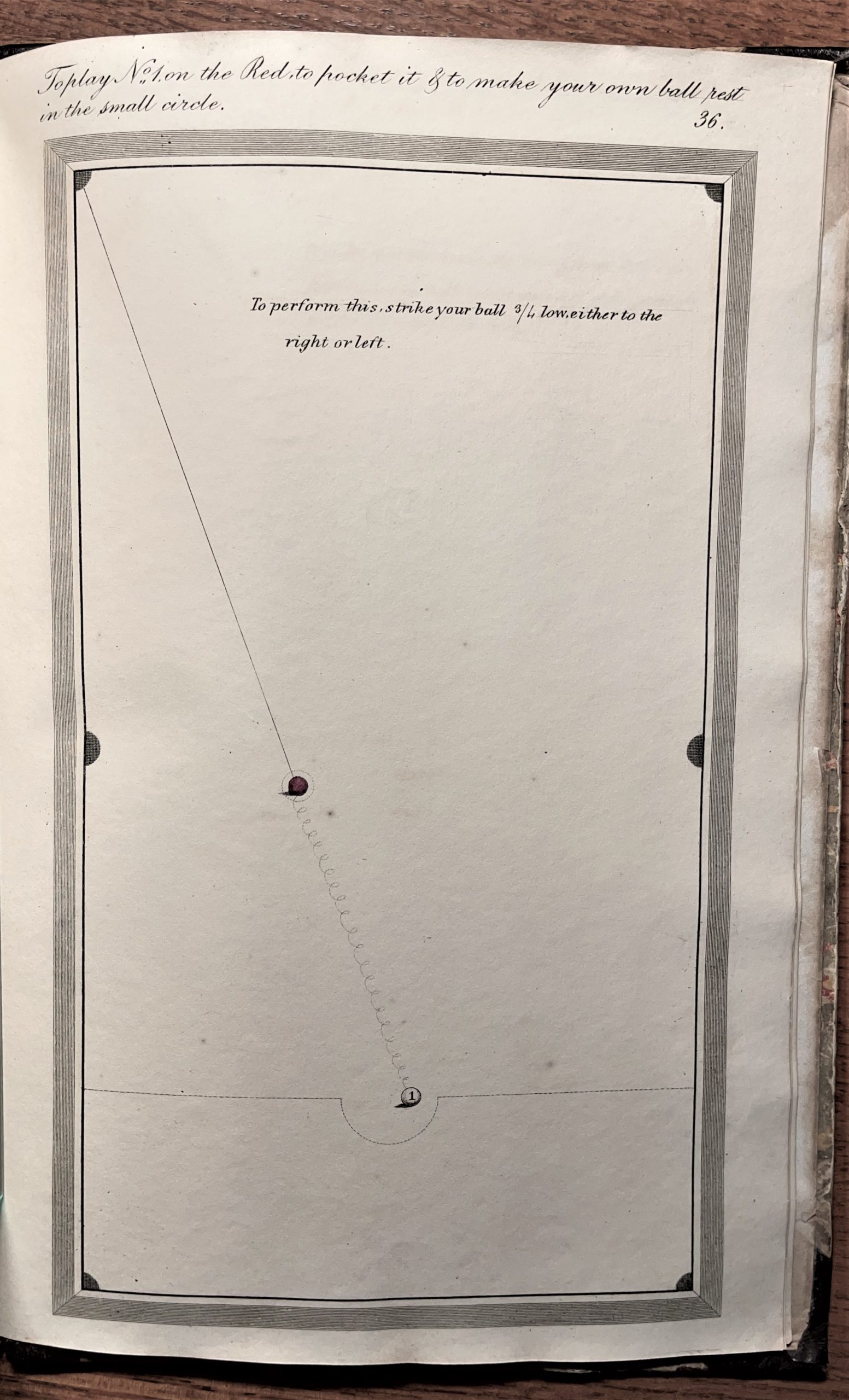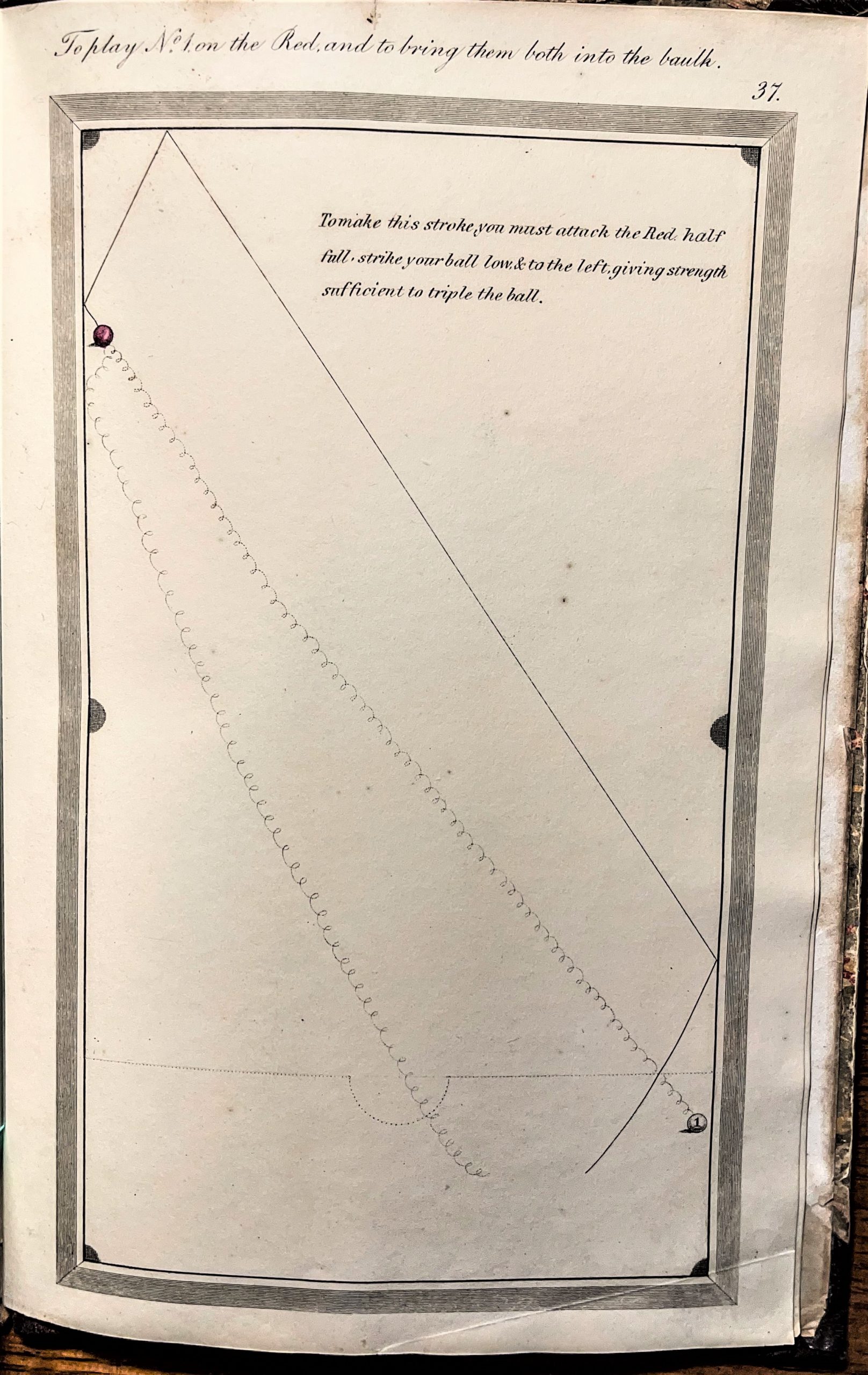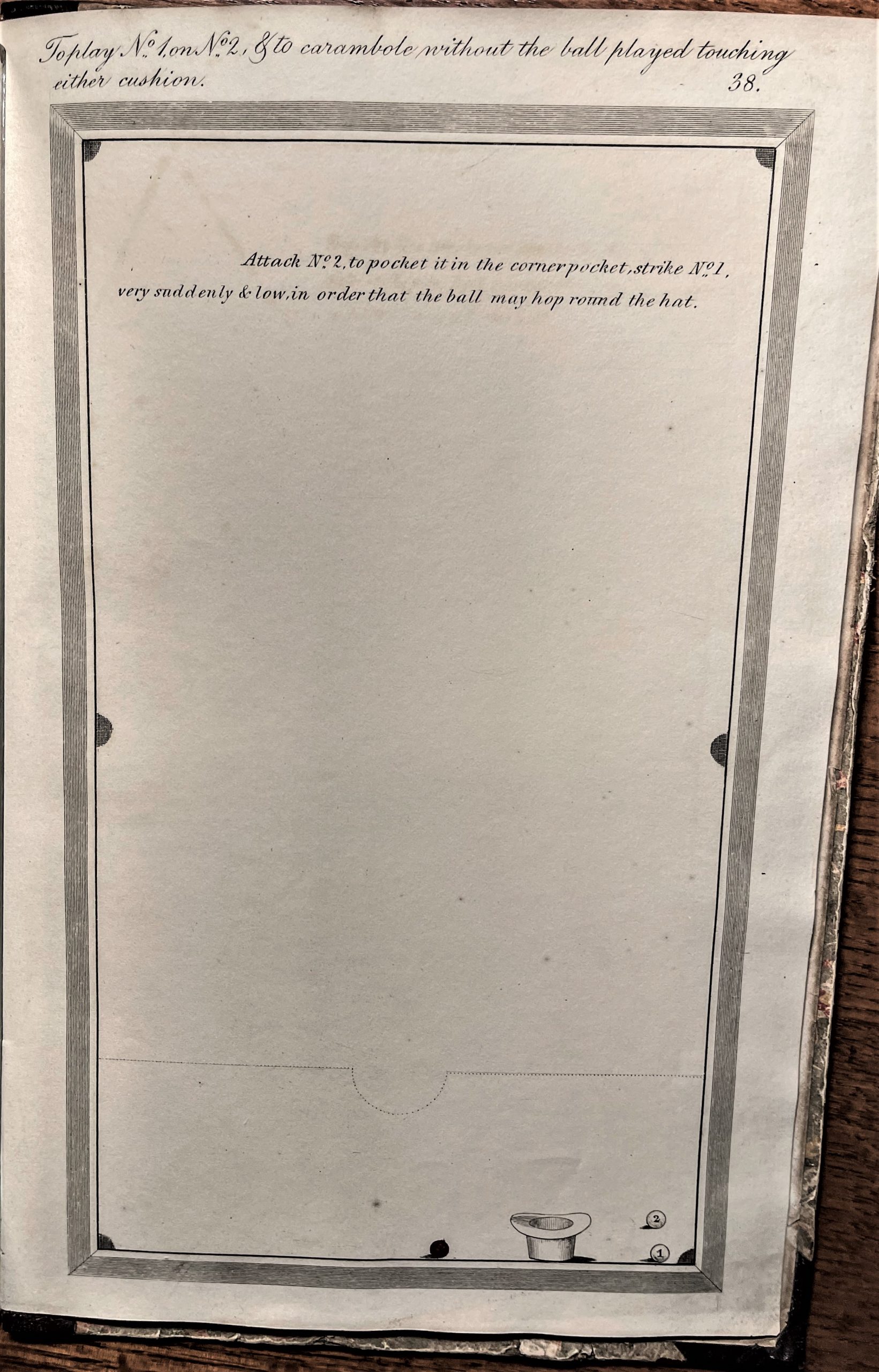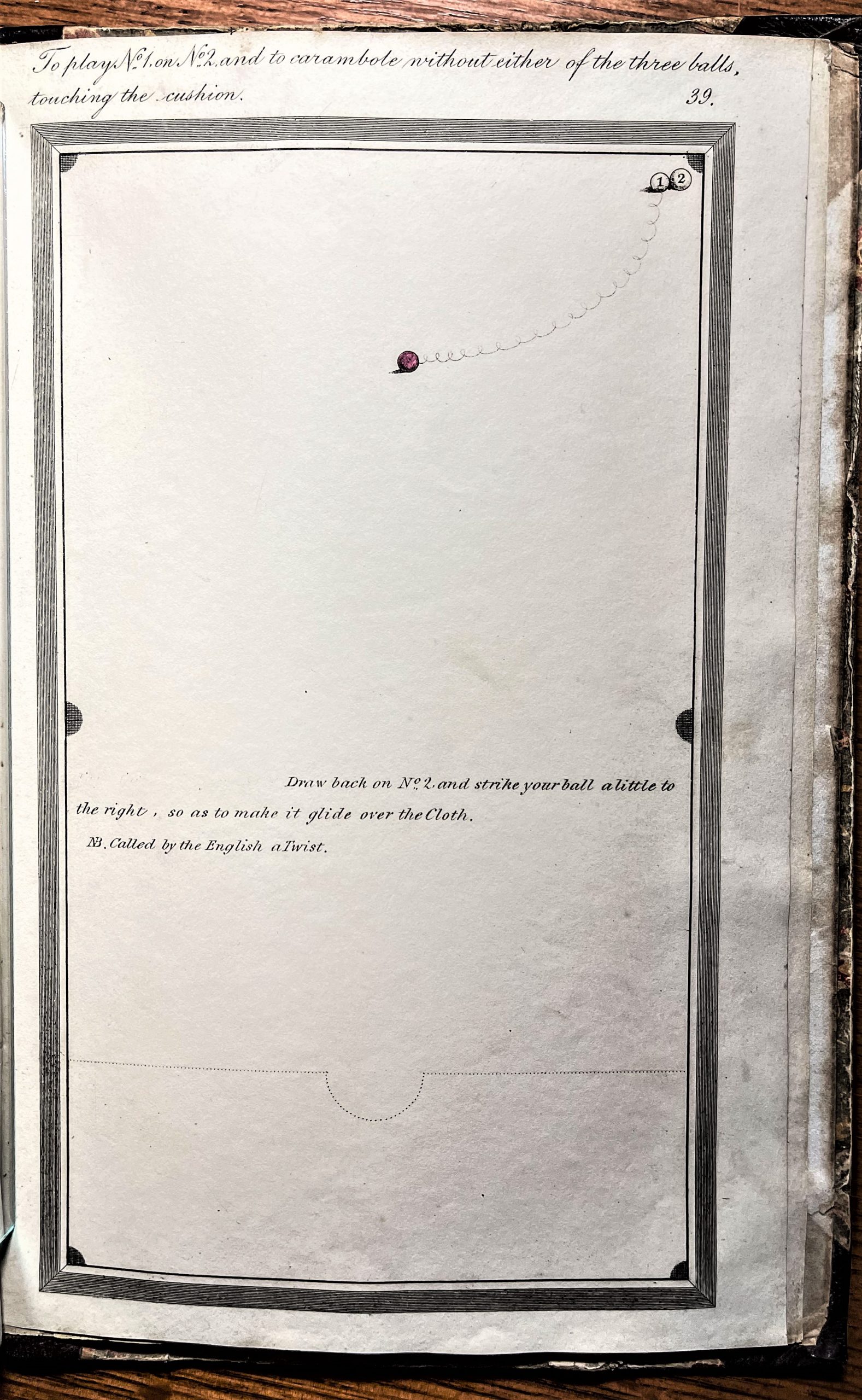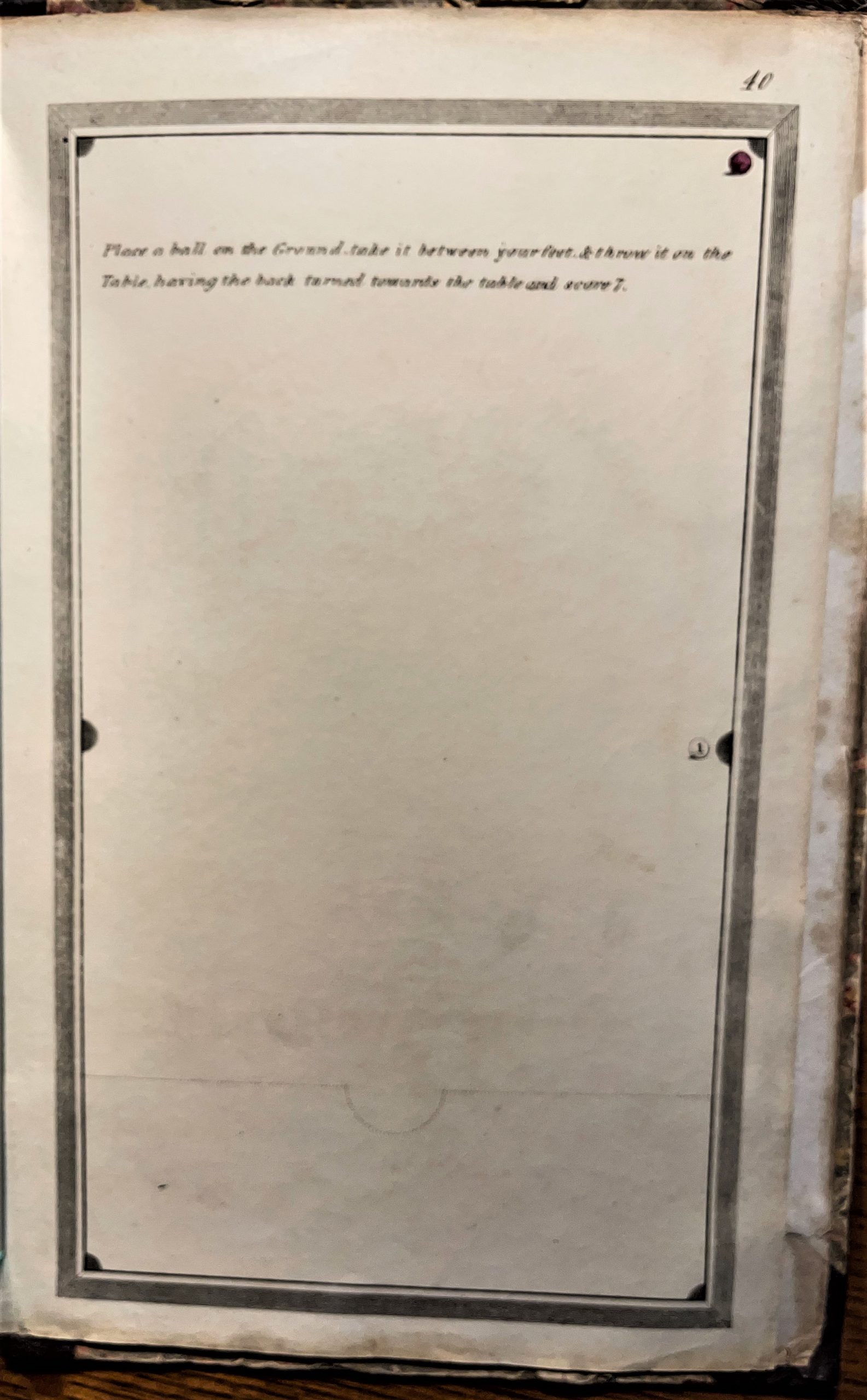Evolution of the Game of Billiards
As Documented in Literature

The chronology of the evolution of billiards in the 19th and 20th century no longer relied on art to tell the story. Instead, early in the 1800s history, billiards is documented in printed text. From the early 1800s on there was an increasing number of books being written about the game of billiards. This was a true indication of the growing popularity of the game in society at that time. Many of the books focus on the rules of the various games, indicating there was an ongoing effort to standardize the games of billiards throughout the world. The “Practical Treatise on the Game of Billiards” 1807 is the oldest written work on the subject of billiards that I have found.


Thanks to Google Books for doing the world a service by now having much of the subject matter of many of these historic books preserved and available on PDF for all of us to read and enjoy. Here is the PDF of E. Whites 1807 book for you to read and better understand the importance of billiards in the 1800s. As you read this PDF copy of this book imagine consider the time it took for an author to create such a work. After all they did not have computers for research, they did not have typewriters for putting ideas down on paper. Everything was written by hand and then set to type. Billiards was a worthwhile subject as there have been reprints of this book over time.
A PRACTICAL TREATISE ON THE GAME OF BILLIARDS - PDF
The following are more books that I have found. You will see the title page and below to it the PDF that you can click on to link to the google book that the title page references.
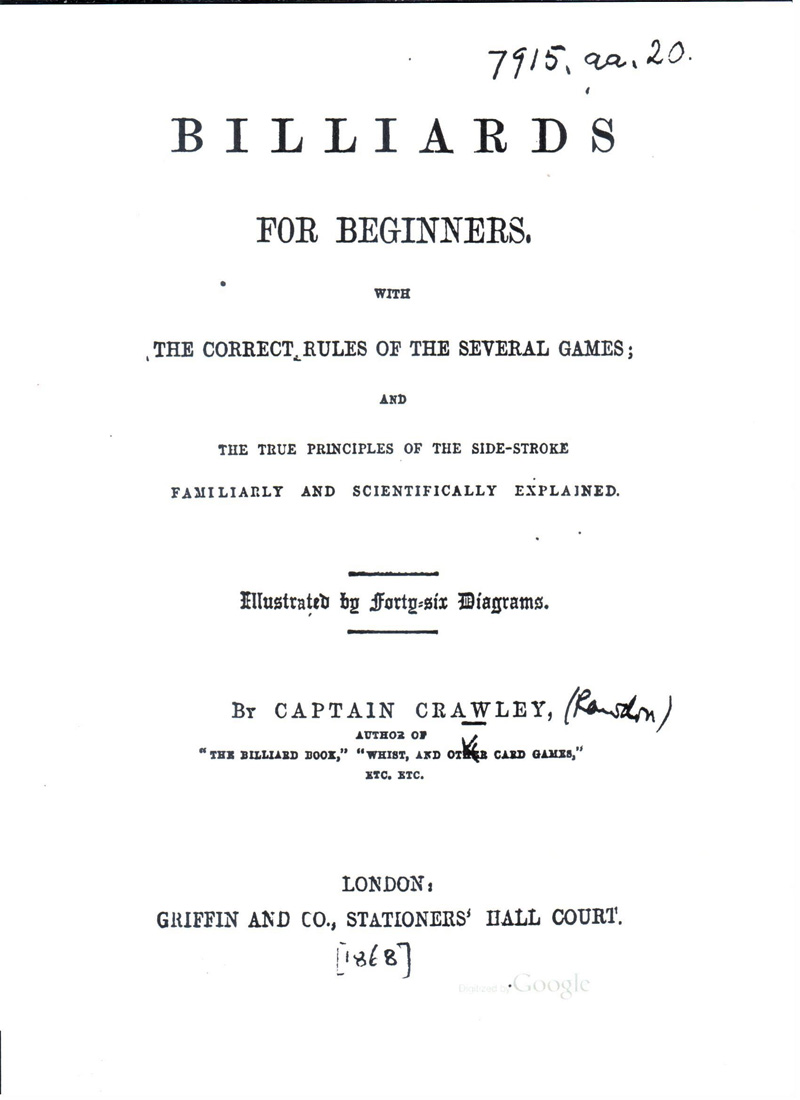
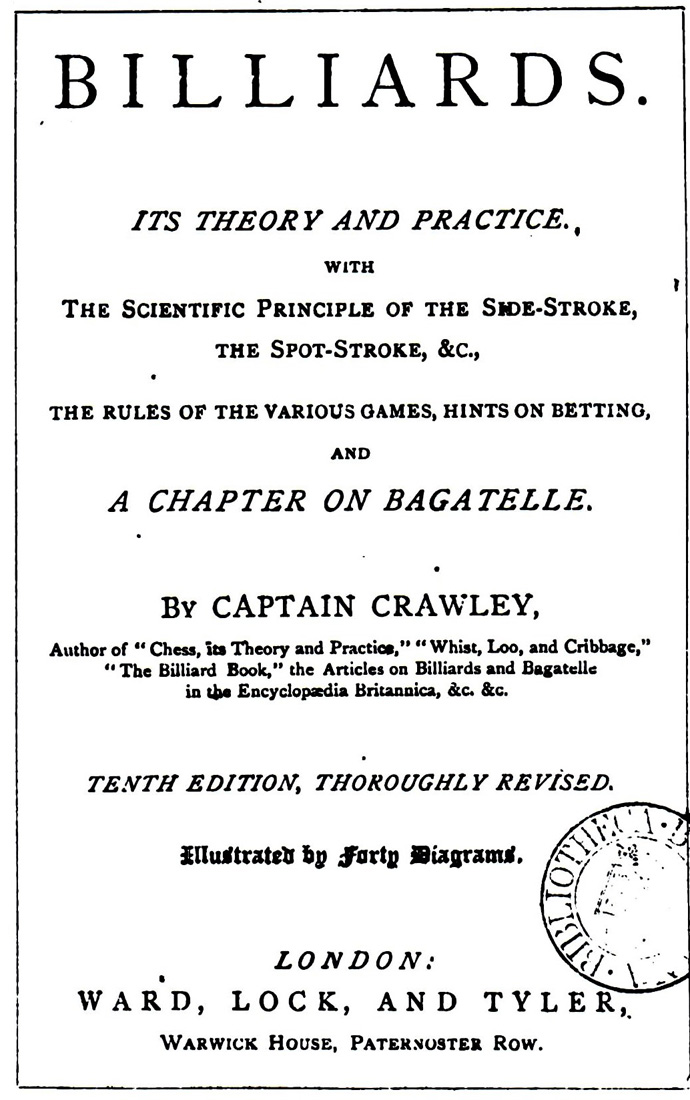
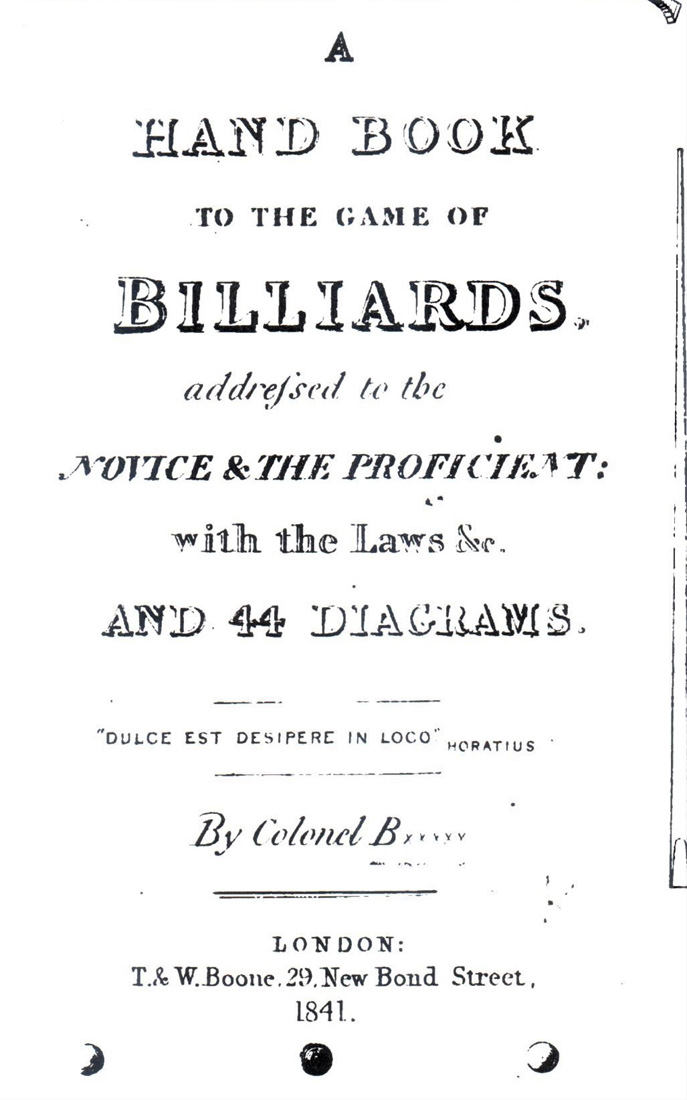
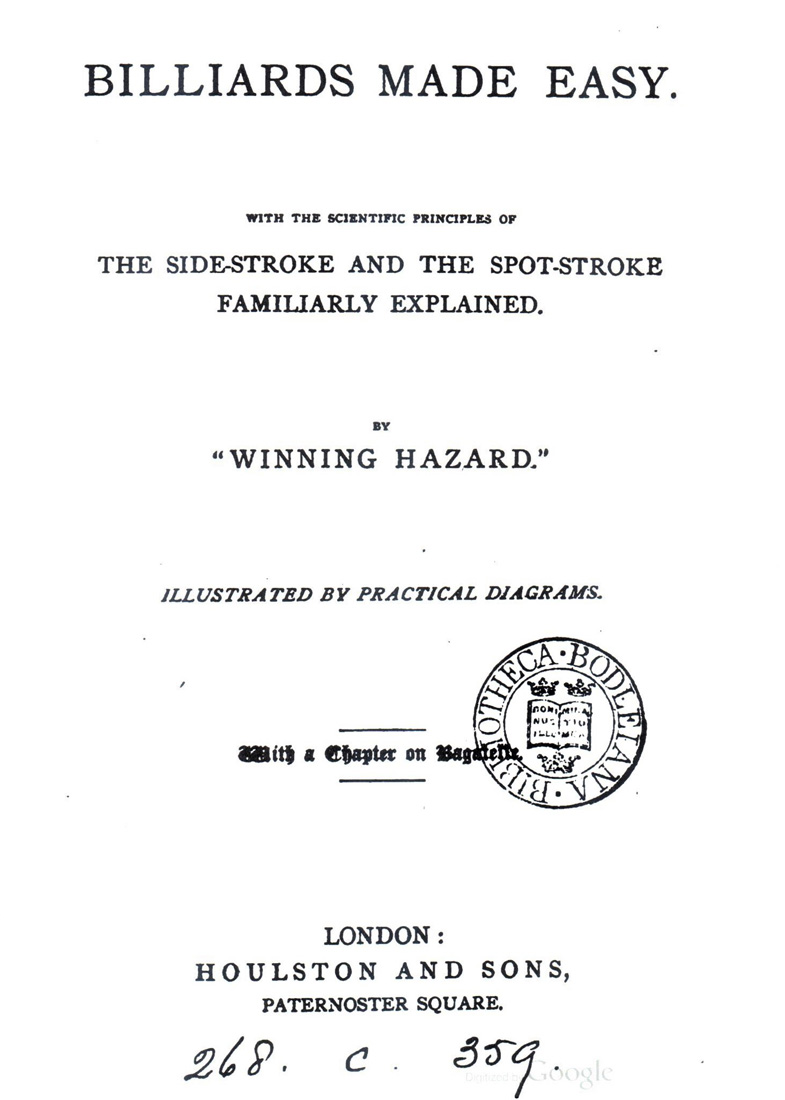
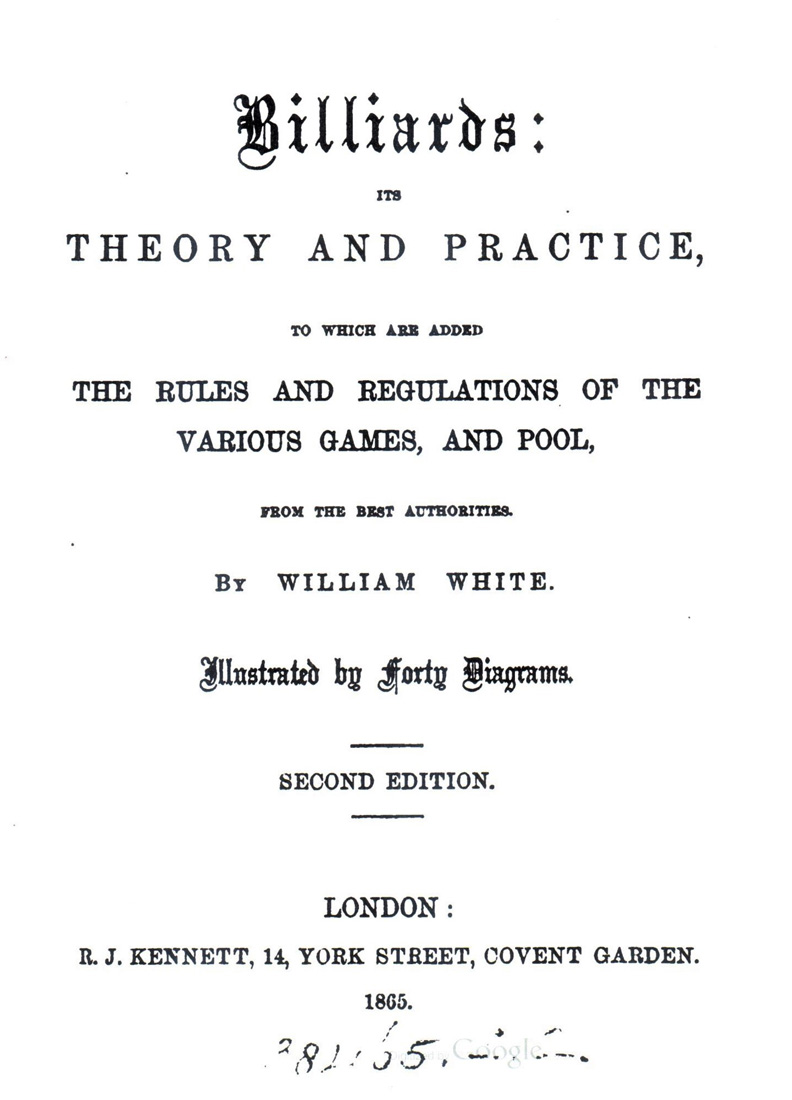
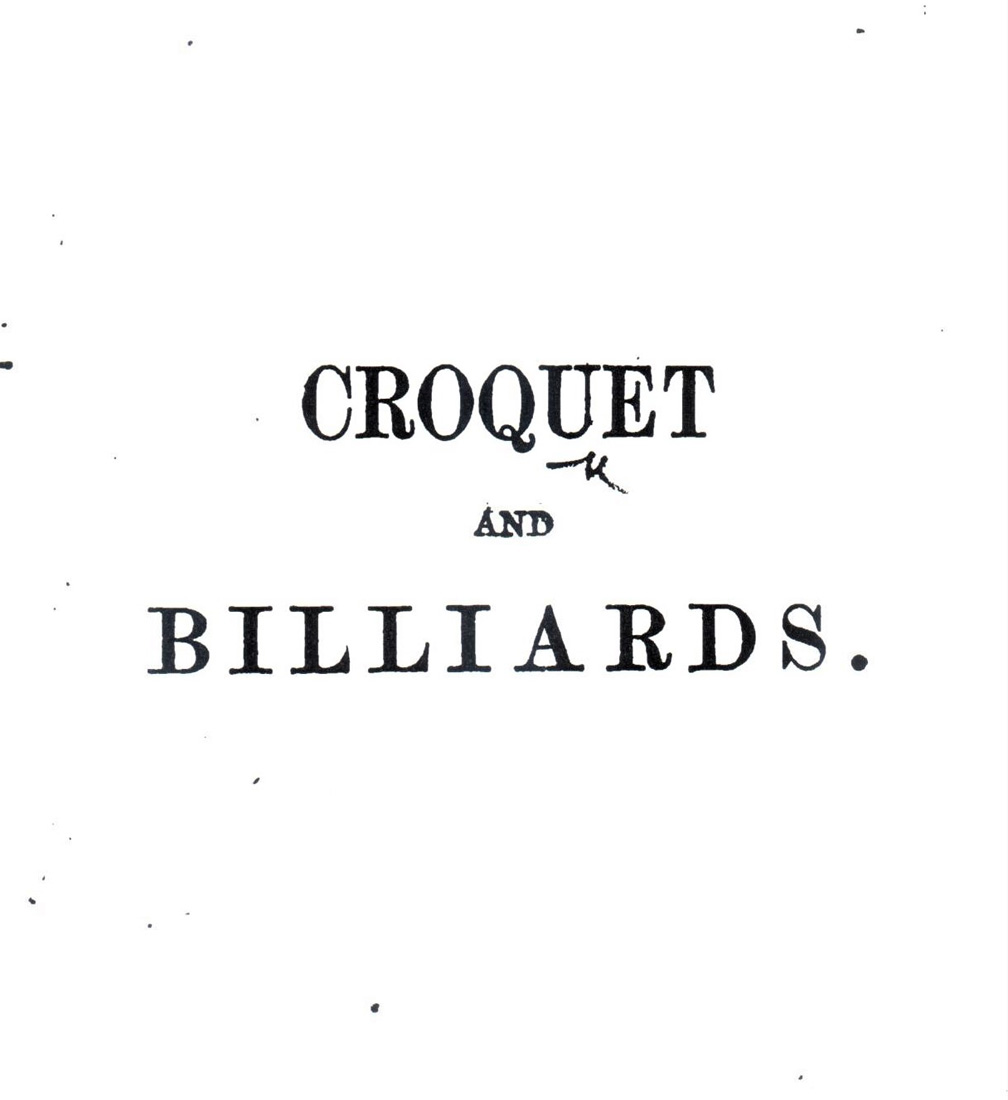
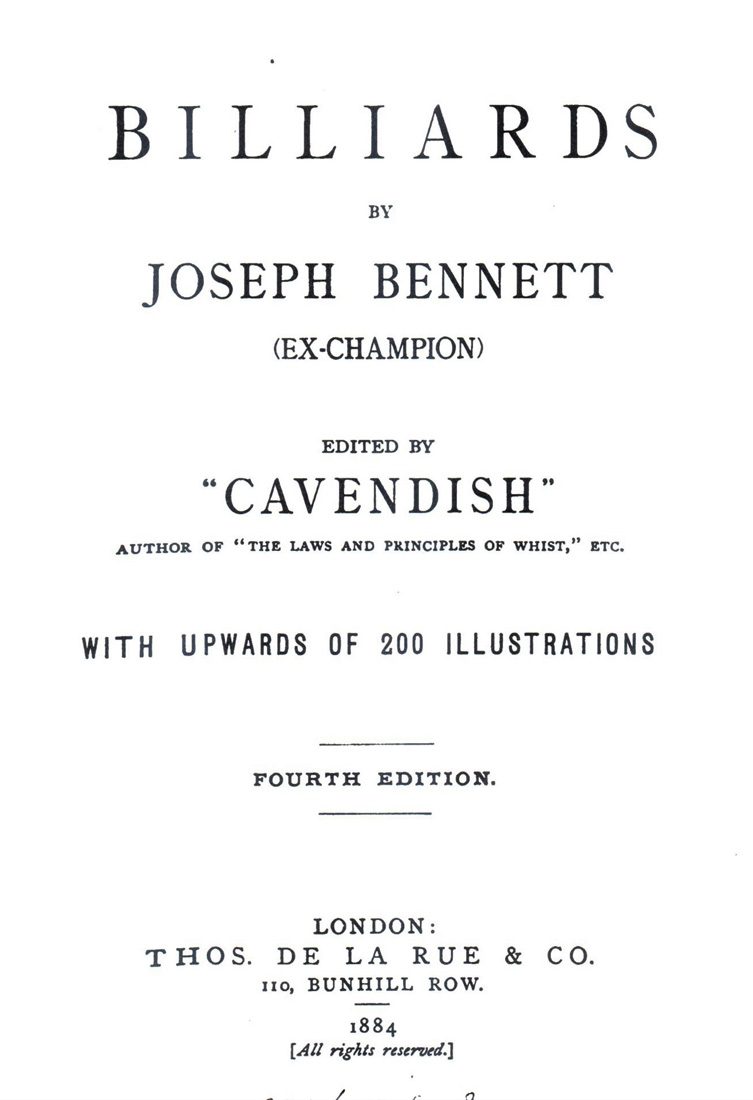
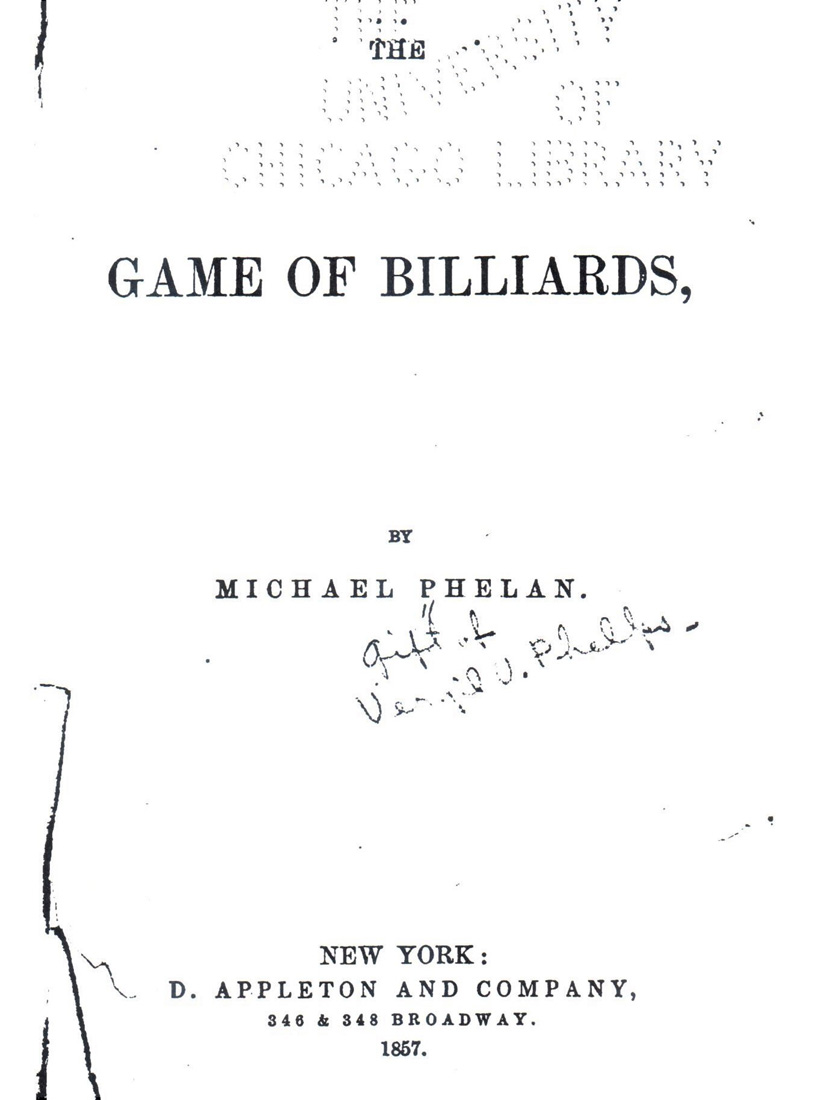
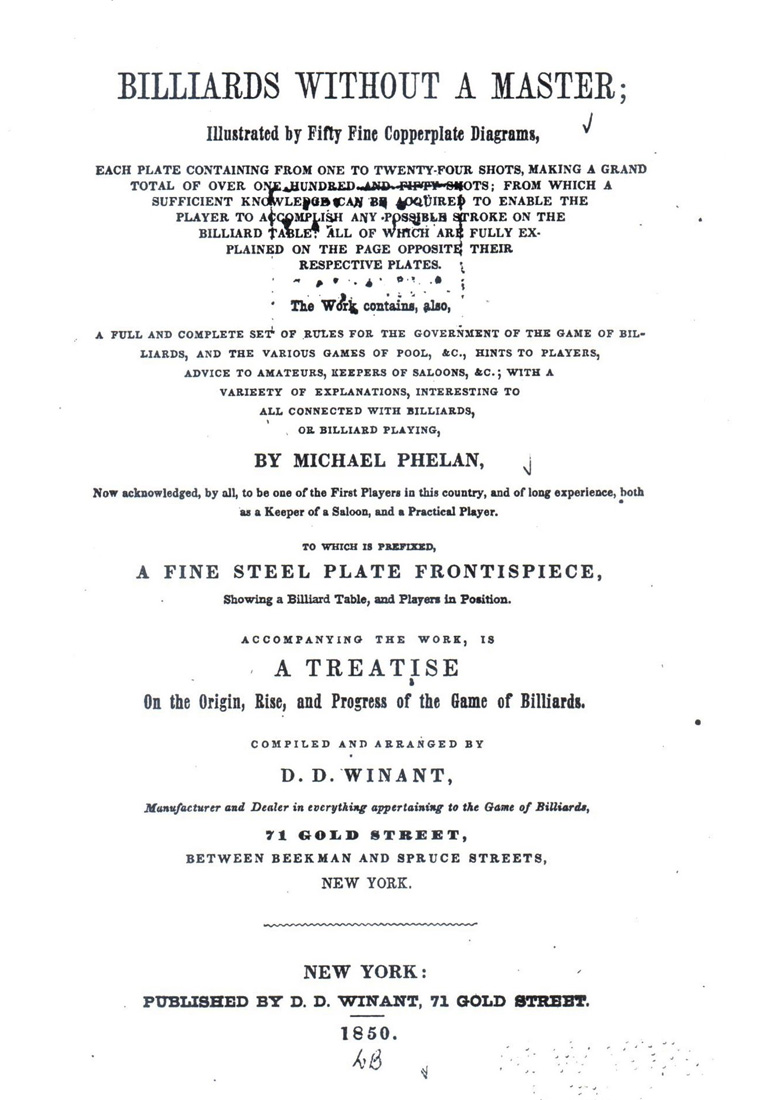
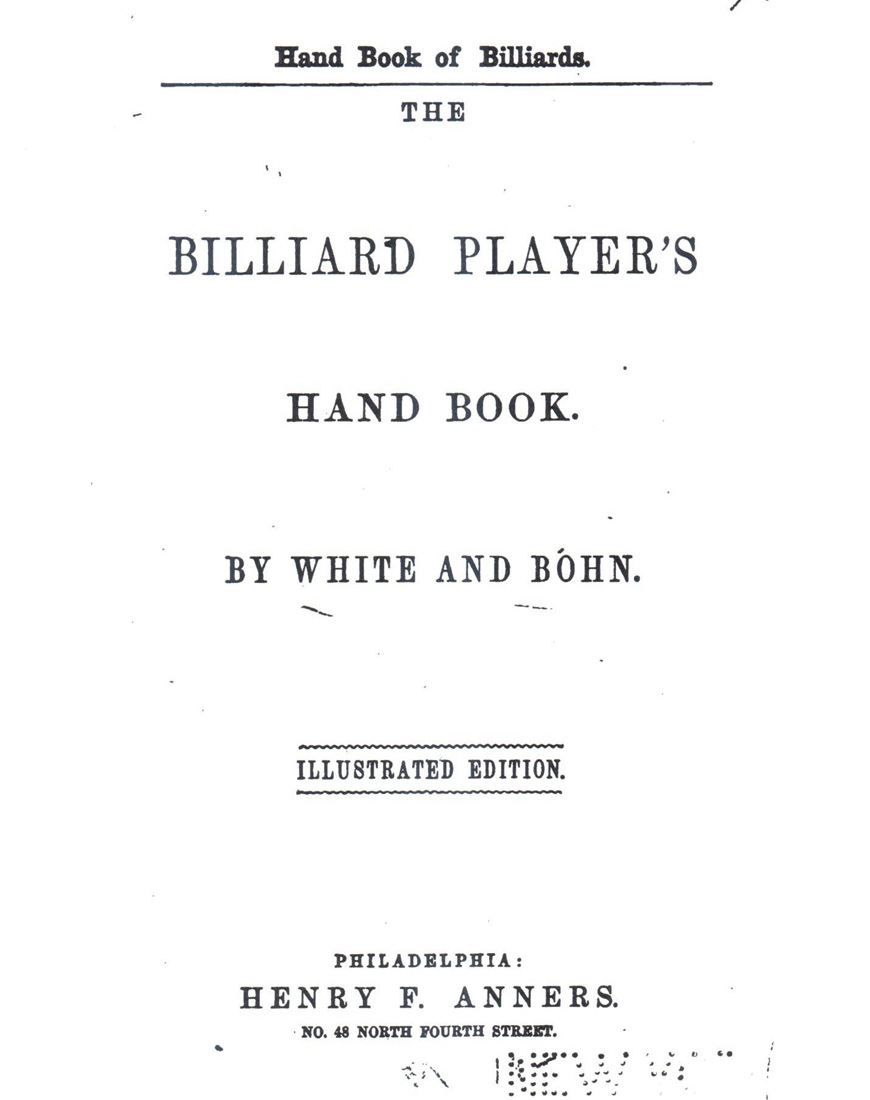
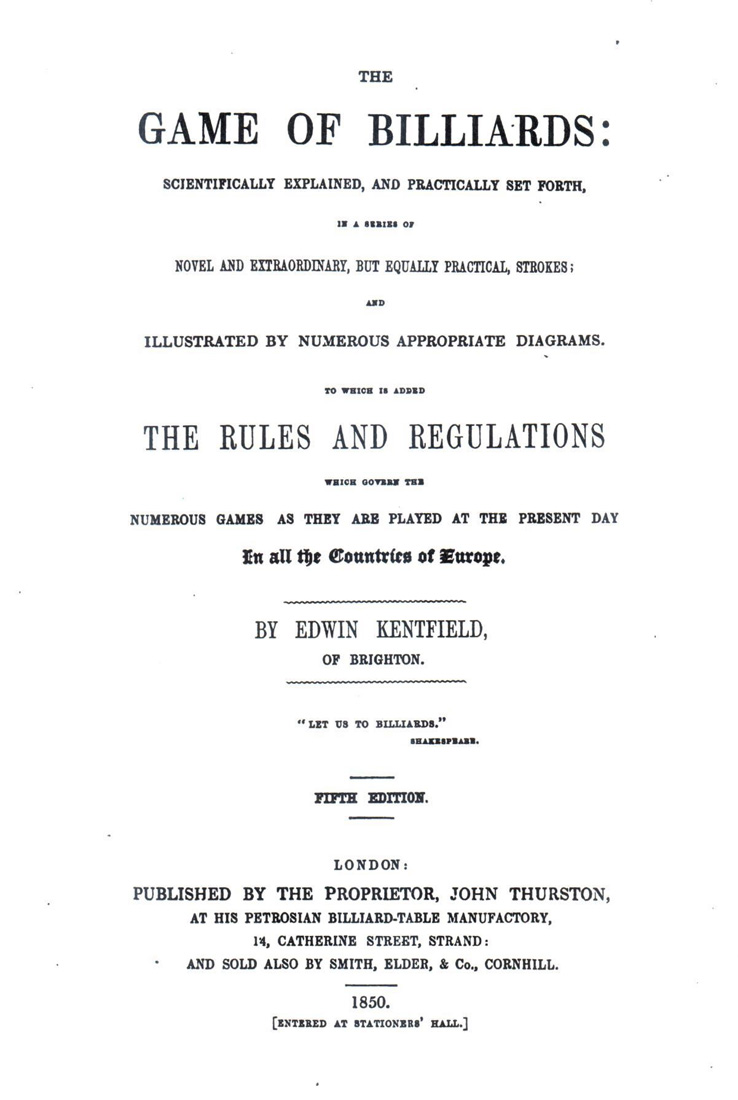
As you have seen in the Billiards in Art section of this website, the billiard cue evolved from a “Mace” used to push or sling the cue ball into the object ball. Players began to use the tale of the mace to strike the cue ball. From there the tapered cue evolved with a hard wooden tip. A French army carom billiards player, Francois Mingaud, is credited with inventing or at least perfecting putting a leather tip on a cue which allowed him to put spin on the cue ball and greatly improve the accuracy playing carom billiards. Here you can read about Francois Mingaud’s contribution to billiards while in a French prison, https://en.wikipedia.org/wiki/Fran%C3%A7ois_Mingaud, Francois Mingaud traveled around France demonstrating is skills as a billiard player. With the leather tip on the cue, he could also hold the cue vertically and strike the cue ball thus he is credited with inventing the “masse shot”. In 1827 Francois Mingaud wrote a French book titled “The Noble Game of Billiards”. In the book he demonstrates, through detailed drawings, the art and skill of billiard shots.
John Thurston (1777–1850) was an inventor who developed the use of slate beds and rubber cushions for billiard tables. John Thurston is referred to as "the father of the billiards table and trade”. In 1799, he founded a business to make billiard tables as well as general cabinet making. The company precedes J. M. Brunswick’s company by nearly 50 years. The company, Thurston & Co. Ltd, continues in business yet today. John Thurston was so impressed by Francois Mingaud’s reputation as a skilled billiard player and author of “The Noble Game of Billiards” that in 1830 John Thurston received permission to translate and print Mingaud’s book for the English billiard community. On its cover it is titled, “Thurston’s Translation of Francois Mingaud’s Billiards, 1830”.
As far as I can tell, Google books has never put a copy of this book out on the internet for viewers to read. I am fortunate to have a very valuable first edition copy of John Thurston’s English translation of Mingaud’s “The Noble Game of Billiards”. I have made copies of each page of that book as best I could without harming this delicate, nearly 200-year-old first edition. Here is the book in its entirety.
Click on Image Below to View Book
As you can see there were several books written in the 1800s regarding Billiards and I am certain there are more that I did not find. I find it fascinating that at a time when the interest in billiards if far less than in the heyday of the 1920’s, there are still numerous books written in the late 20th century on the subject of billiards. I expect there are far fewer books in print today than say 30 years ago. With the younger generation so focused on the internet and electronic games I wonder if there will be any interest in billiard in a generation or two.
One of the most compelling of what I would call modern books on the history of billiards was published in 1974. It is a must read for any billiard historian. It is the “History of Billiards” written by William Hendricks. Mr. Hendricks, an intercollegiate billiard champion and scholar, documents and discusses early opinions and facts regarding the evolution of billiards up to modern times. Think back, there was no internet in 1970. One must pause for a moment to appreciate the time and labor invested by Mr. Hendricks to communicate via snail mail with others around the world as he pulled together the background for his published work. Times and dates of events in billiard history that are covered in the manuscript can be found no were else. Unfortunately, this 54-page manuscript is out of print. You may find a copy of this publication on eBay or Amazon if you are lucky. Mr. William V Hendricks pass away at age 90 in 2015. Mr. Hendricks’ work is certainly worthy of being preserved and yet unfortunately I doubt there is enough interest to pay for the cost of reprinting this fine work. I have been unable to find an heir of Mr. Hendricks who might give me permission to print this work in its entirety on my website.
I was fortunate to find a copy of Mr. Hendricks work. What was particularly interesting was a flyer I found inside the manuscript when I received my copy. The flyer along with my copy of the manuscript had been originally sent to the “President, Billiard Congress of America” and was post marked St. Louis, Mo. 1979. Four years after being published, Mr. Hendricks was still trying to get the word out regarding his work. I wonder if Mr. Hendricks ever sold all copies of the first printing. I discussed the terms “billiard” and “pool” in another section of this website, “Billiard Table or Pool Table”. I find it interesting that it isn’t until the last two pages of Mr. Hendricks manuscript that he uses the term pool. Good for Mr. Hendricks in that he appreciated the difference between the terms pool and billiards. He uses the term “POOL” in reference to the game being played in the U.S. in the 1920’s. This is an almost certain reference to the 20th century American slang term for “BILLIARDS”.

On pages IV and V of Mr. Hendricks’ manuscript there is a chronology of the history of billiards that puts the likely origin and evolution of the game in prospective:
“A BRIEF CHRONOLOGY OF THE HISTORY OF BILLIARDS (1)”
“This chronology of important events belonging to the history of the game of billiards is based, of course, on documented facts, on research, sometimes on educated conjecture. The events span a period beginning in the Middle Ages and extending through the year 1900, by which time billiards may be said to have assumed most of its modern characteristics. Of necessity the dates sometimes can place an event only approximately, and by reference to the earliest (or latest) documentation. The earliest documented existence of a billiard table, for instance, was in 1470. But it is entirely likely that a few tables existed even earlier. Of necessity only the more important events are listed here. A chronology can begin to give shape to a historical picture but should be used only as a supplement to the material from which it is taken in William Hendricks’ History of Billiards.”
- William Hendricks; William Hendrick’s History of Billiards, A compleat Historie Of Billiard Evolution; Published by William Hendricks, Roxana, IL 1974, pages Iv & v
| Year(1) | Event (1) |
| 1164 | The word bille already being used to refer to certain medieval ball games. |
| 1350 | Probably the earliest documented billiard game, played on a field in France.
Approximately the period of the “figure striking at a ball with a crooked stick” in the Gloucester Cathedral window and of Joseph Strutt’s illustration of ground billiards. |
| 1460 | Approximately the period of a game of ground billiards played by shepherds and depicted in a French tapestry. |
| 1470 | The first known billiard table, purchased by Louis XI of France. |
| 1480 | A noble family in France purchases “two games of billiards, complete with billiard table.” |
| 1514 | “A large table for the game of billiard covered in green cloth” is listed on the inventory of the possessions of a French duchess. |
| 1578 | Billiard tables are licensed in Holland by the Lombards. |
| 1586 | Mary, Queen of Scots, is deprived of her billiard table at Fotheringay Castle. |
| 1588 | The duke of Norfolk and the Earl of Leicester own billiard tables in England. |
| 1591 | Edmund Spenser described billiards as a thriftless game. |
| 1605 | King James I of England orders a table to be made by “Henry Waller, our joyner” – probably the first known builder of an English billiard table. |
| 1609 | Shakespeare’s reference to billiards in “Antony and Cleopatra”. |
| 1610 | The billardiers paulmiers receive from the French Crown the sole rights to administer public billiard rooms. |
| 1611 | Billiards described in Randle Cotgrave’s Distionairie of the French and English Tongues. |
| 1616 | Ben Johnson remards on the smoothness of the billiard ball in his play “The Devil Is an Ass.” |
| 1656 | Cromwell enjoins the justices of Herford County to suppress alehouse keepers who allow customers to “playe at Billiard Table” on Sunday. |
| 1665 | The first known book containing instructions for billiards, La Maison de Jeux Academiques, published in Paris. |
| 1666 | Billiards available to the public at fifty-seven licensed locations in Paris. |
| 1674 | The first known English work containis instructions for billiards, Charles Cotton’s The Compleat Gamester, published.
It is permissible to use the small end of the mace if the ball lied too close to the rail – this is the first step in the evolution of the cue. |
| 1679 | Billiards played with the “small end of the billiard stick, for the most part of the game” at the Portuguese ambassador’s estate in London. |
| 1682 | Parisian courtiers seated on couches of green velvet with gold fringes see Louis play billiards under “twenty-six crystal chandeliers” on one of his two tables. |
| 1684 | Howlett’s School of Recreation published, containing England’s second published set of instructions for billiards in ten years. |
| Year(1) | Event (1) |
| 1690 | Billiards may still be played “on specially prepared ground in the garden” according to Furetiere’s dictionary. |
| 1709 | William Byrd II of colonial Virginia plays billiards with Mrs. Byrd on his plantation. |
| 1717 | Louis XV plays billiards at age seven in France. |
| 1723 | Late-night billiards playing restricted by the French in the five year old city of New Orleans. |
| 1734 | First recorded mention n print of the billiard cue (“the stick”) appears in Seymour’s updated Complete Gamester; and in the same work a new variety (“French billiards”) is added to the existing modes of English play. |
| 1763 | The young Scotsman James Boswell plays billiards in London. |
| 1765 | A billiard room is constructed by the French in the one year old city of St. Louis in the present day state of Missouri. |
| 1773 | The important Covent Garden Magazine treatise on billiards appears in two installments.
The work “cue” first appears in an English treatise on billiards; the word “trailing” is first defined and the technique described; the carambole game, using a third ball, first appears in English rule books to become the precursor of modern billiards. “In England the mace is the prevailing instrument with few foreigners excel with” and the arch and king are “now wholly laid aside.” (The Covent Garden Magazine) |
| 1775 | John Dew’s treatise on billiard appears in Hoyle’s Games Improved. |
| 1779 | Dew describes how the mace may be used as a mechanical bridge by the cue player. |
| 1790 | The invention of the Jeffrey, a cue bevelled at the tip to allow for striking the ball below the center. |
| 1792 | Louis XVI and Marie Antoinette play billiards on the eve of their imprisonment. |
| 1797 | The “white winning game” played with two white balls is the “game commonly played” in England. |
| 1799 | John Thurston goes into business as a billiard table and general cabinet maker in London. |
| 1800 | Cues and maces being sold in equal numbers in England. |
| 1801 | An anonymous work, Game of Billiards, published in London by T. Hurst is the first English work devoted completely to billiards. |
| 1803 | Billiard table making has become “generally a branch by itself” of the furniture industry, according to Sheraton. |
| 1805 | Wooden billiard balls still in use in France according to Academie Universelle des Jeux; the book is also one of the few to mention “trailing” outside o f England. |
| 1807 | E. White’s A practical Trestise on the Game of Billiards published, probably the most comprehensive work on the game yet printed in any language.
The effects of vertical spin on a ball first described in print, by White. White is the first used of the terms “object ball” and “cue ball.” |
| 1814 | John Thurston’s furniture company devotes itself wholly to the billiards industry. |
| 1818 | Thurston’s first sales notation of “a cue tipped with leather.” |
| 1819 | A game called “pool” begins to appear in English rulebooks. |
| 1820 | This early in the century, Phelan said, Americans used the mace almost exclusively. In England the cue has clearly superseded the mace. |
| 1823 | John Carr becoming famed as the “father of the side stroke.” |
| 1825 | British champion John Carr defaults a billiard match to Edwin Kentfield, who becomes the new national champion. |
| 1826 | John Thurston is experimenting with his new invention – slate bed for billiard tables. |
| 1827 | Mingaud’s Noble Jeu de Billiard published in Paris. |
| 1828 | Opponents of President John Quincy Adams in this presidential campaign year had Adams’ presidential billiards in mind when they charged that he kept “gaming tables” in the White House. |
| 1830 | Mingaud demonstrates the marvels of “English” in London; Thurston published Mingaud’s book in an English translation. |
| Year(1) | Event (1) |
| 1833 | A billiard table hauled by mule train to Brent’s Fort, on the Santa Fe Trail in Colorado. |
| 1834 | Thurston introduces the Imperial Petrosian Billiard Table with its slate bed. |
| 1835 | Thurston’s new invention, India rubber cushions, replaces the old cloth-stuffed cushions. |
| 1838 | Queen Victoria has a new Thurston table installed at Windsor Castle. |
| 1845 | Thurston patents has improved vulcanized rubber cushions.
John Brunswick, a Swiss immigrant, begins making billiard tables in the United States. |
| 1849 | Edwin Kentfield loses the English billiard championship, through default, to John Roberts of Liverpool. |
| 1850 | The English work Bohn’s New Handbook of Games published in Philadelphia, containing a treatise on billiards. A.E. Schmidt enters the billiard field.
Michael Phelan’s Billiards without a Master, the first American book on billiards, is published. The game of four-ball carom billiards is the most popular in America. The erect address with the cue is still favored, and the striking motion still involves the entire arm. “Indeed the mace is now scarely used except by ladies” (Bohn). |
| 1855 | Napoleon III sends an ornate nine-foot billiard table to Russia as a gift for the coronation of Tsar Alexander II.
The Phelan and Collender company formed; it would be for a number of years the largest and most important billiard manufacturer in the country. |
| 1856 | The first of Phelan’s patents granted for his redesigning of the American billiard table.
Phelan inaugurates The Billiard Cue, a small monthly magazine. |
| 1859 | The first American championship billiard match played, between Phelan and John Seereiter in Detroit, with Phelan winning. |
| 1860 | The first intercollegiate billiards match played, between Harvard and Yale in Worcester, Massachusetts. |
| 1863 | The proper address with the cues is to confine the striking motion to the lower arm--almost modern.
The mace “still much used by ladies and children in their attempts to learn the rudiments of the game” (Phelan). |
| 1864 | The first official state billiard championship played, in Connecticut.
Charles Dickens has a Thurston table delivered in time for Christmas. |
| 1868 | John Wesley Wyatt invents celluloid, a synthetic substitute for ivory billiard balls. |
| 1870 | William Cook beats john Roberts in the first official championship in English billiards. |
| 1875 | Snooker invented by British officers garrisoned in India. |
| 1876 | Mark Twain and Bret Harte write a new play, working in the billiard room on the third floor of Twain’s house in Hartford, Connecticut. |
| 1878 | First official American Pocket Billiards tournament. |
| 1879 | The Brunswick-Balke-Collender Company formed by the merger. |
| 1891 | By this time mace-play is formally dead. “All strokes must be played with the point of the cue” (B.A.C.C.). |
| 1896 | Major Broadfoot’s thick book Billiards published in the Badminton Library sports series.
The address with the cue now recognized as correct is the modern low-over-the table stance, with the pendulum swing of the forearm. |
| 1909 | Maces still for sale, possible for the last time anywhere, according to Brunswick-Balke-Collender advertisements in the United States. |
- William Hendricks; William Hendrick’s History of Billiards, A compleat Historie Of Billiard Evolution; Published by William Hendricks, Roxana, IL 1974, pages Iv & v
I believe the most thorough and illuminating books of modern times are The Billiard Encyclopedia, An Illustrated History of the Sport, written by Victor Stein and Paul Rubino, now in its third edition and Pool & Billiard Collectables, copyright © 2003 by Mark and Connie Stellinga.

Let’s talk first about the Billiard Encyclopedia and come back to Pool & Billiard Collectibles later.


The first edition of the Billiard Encyclopedia was published in 1994. This book is pictured to the left of the front cover the of three editions shown above that are part of my library. This literary work is massive at 500 pages. Even though the interest in Billiards was in steep decline the interest in the history of billiards and the collecting of historical billiard items was near its peak in terms of outrageous expected values. Victor Stein and Paul Rubino felt compelled to research and write this first edition. I can’t imagine how many hours went into the research and writing of this work with no expectation that the book would ever be printed and sold in the market. This book covers the evolution of the game in far more detail than my humble work on the pages of this website. The work covers the history of billiards in Europe and also America. It talks about cue construction and legendary and current cue makers up to the date of printing. It also touches on the subject of collecting of billiard items. This is a must have book and can be found occasionally on eBay.
The first edition of the Billiard Encyclopedia sold out. In 1996 the second edition of this book was written. It also is massive at 554 pages and makes a fine coffee table book. The book covers some of the same materials as the first book. But in addition, it talks about billiard tables, cloths and balls. It concludes with “Voices from the Past” which is a brief discussion of other works written on the subject of billiards. These few pages at the end of the Billiard Encyclopedia can lead you to many more written works on the history of billiards should you be interested.
The second edition of the Billiard Encyclopedia sold out. The third edition of The Billiard Encyclopedia was printed in 2008. We are now talking about at least 20 years of labor by Victor Stein and Paul Rubina as they felt compelled to continue the story of the history of Billiards. This third edition to is massive having a total of 629 pages. The fact that there is a third edition of The Billiard Encyclopedia says something about the ongoing interest in billiards around the world. I feel that interest in billiards is waning in 2021. You can get the third edition from several sources on the internet. If you wish I can give you Victor Stein’s email address and you can get an autographed copy directly from Victor. There is new material in the third edition that was not in the earlier two editions. Of great interest to me is the subject of cue construction. While modern cues are not my thing there is an extensive section on modern cue makers. My favorite is a section covering billiard collectors of the time. You will be amazed at some of these collections and most put my collection in its lessor place.
Along with the Billiard Encyclopedia you may also find the Blue Book of Pool Cues on eBay. I wish the Blue Book would have referred to them as billiard cues rather than pool cues which I feel is a put down to the sport of billiards. The Blue Book covers a bit of history but some of the dates are suspect. This book focuses on the value of billiard cues. I feel these stated values are for the most part over stated in today’s world.

Another scholarly work that is worth having in your library is The Complete Book of Billiards, by Mike Shamos, copyright 1993. I am not certain it should be considered an historical document covering the game of billiards. I would instead put it in the category of the published “Wikipedia of billiards”. Mr. Shamos, a scholar, has created a dictionary of billiard terms used throughout time in this book. Mr. Shamos has also written, Shooting Pool, The New Illustrated Encyclopedia of Billiards, and Pool Mr. Shamos certainly invested much time writing about Billiards. These books sell, or he would not have kept writing on the subject.

If you have an interest in snooker, a proper British billiard game invented in 1885, find a copy of The Story of Billiards and Snooker by Clive Everton, copyright 1979. My copy came to me via Amazon from a book conservator in England. The book is quite musty. I am not certain whether this odor is from the constant rain in England these past 30 years or the fact that the book was never read. I find it fascinating that the author had such a passion for the game of snooker that he would take the time to put together this documentary of the great snooker players of the past century.

This next book is a must read for the pool player that likes to wager on the game in smoke filled bars. The book is Billiards, by John Grissim, copyright 1941. No doubt this was a time when billiards was popular in smoke filled billiard rooms as I can attest to when growing up and watching my father play pool. The caption under the title reads “Hustlers & Heroes, Legends & Lies and The Search for Higher Truth on the Green Felt”. This book is a good read if you are interested in the pool players that have been immortalized but came from the seedier side of the game. In the earlier part of the 1900’s Brunswick-Balke-Collender was on a crusade to promote billiards as a wholesome game for the family. In 1941 along comes John Grissim to glamorize the games that were played in smoke filled rooms where hustlers plied their skills at scamming the uninformed player of lessor skill. I doubt that Brunswick-Balke-Collender Co. ever promoted this book.

Finally, Pool & Billiard Collectables, copyright © 2003 by Mark and Connie Stellinga is a must have coffee table book for anyone who has an interest in collecting antique billiard items. This book offers a glimpse at billiards past history through Marks personal collection of many of the finer billiard cues and collectables going back several hundred years.
I have three copies of Mark’s book. The one shown below was the first purchased. I use it frequently as a reference book. It is tabbed and has a lot of writing in the margins. I purchase a second as a coffee table book in my billiard room. I received a third copy as a gift. Since re-gifting is not a good thing, I will save it for when this book goes out of print.
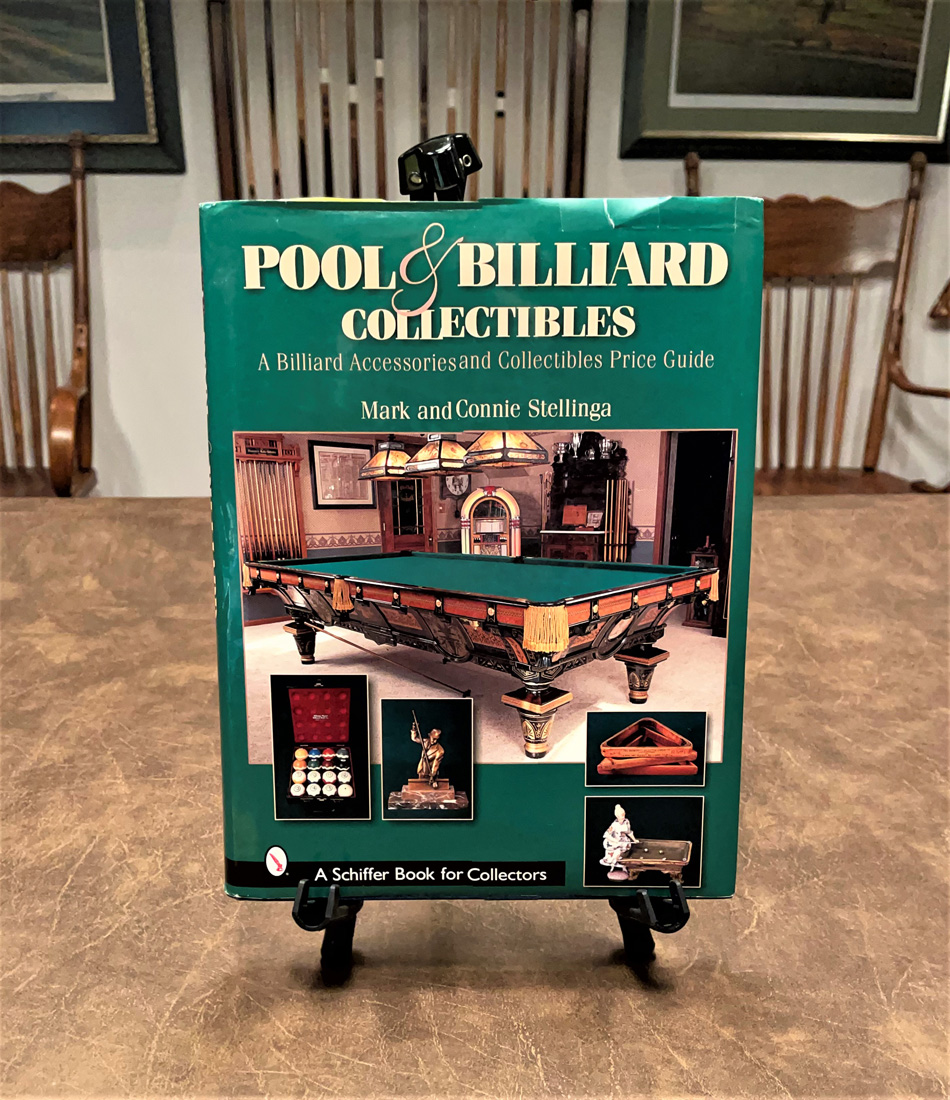
The collection of billiard items in Mark’s book is quite an impressive display of one couple's 30 plus year pursuit of the very best in historical billiard cues, tables, advertising, etc. The Stellinga’s are to be commended for their hard work in putting together a high-quality book to document their billiard collectables that others including myself can only wish we had found. This book can be found on eBay as well as other web sites. I am certain anyone who collects antique billiard items know the Stellinga’s personally or at least knows of Mark and Connie Stellinga. What most do not know is that Mark’s talents are quite diverse and go far beyond billiards. He is an accomplished, published poet, http://www.authorsden.com/visit/viewwork.asp?AuthorID=25550. His Victorian furniture restoration projects are museum quality. If that is not enough, his vintage car restoration projects are of concourse quality.
I expect Pool & Billiard Collectables is referenced to more often than any other book by computer savvy people who wish to provide some provenance to a billiard item that they are selling on eBay or other on-line auctions.

